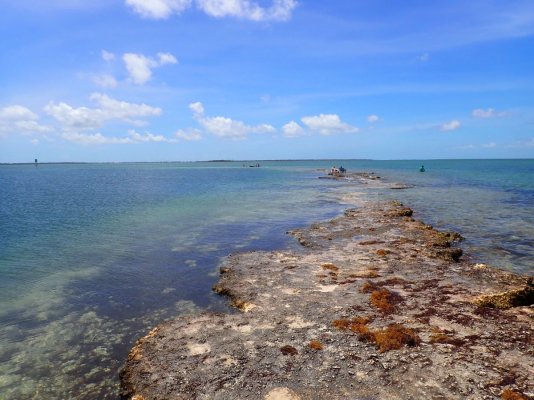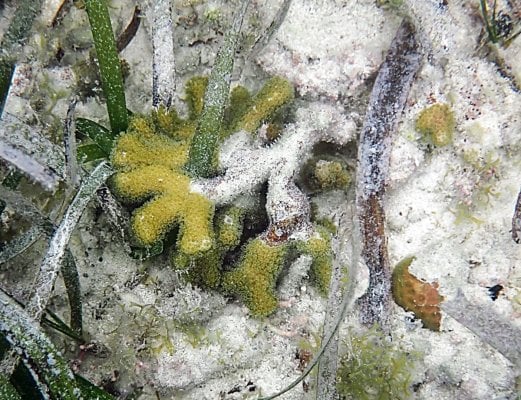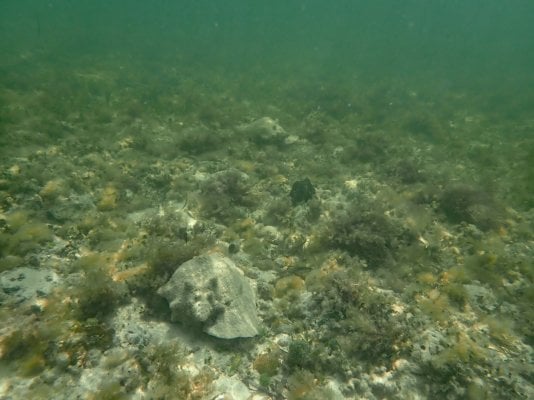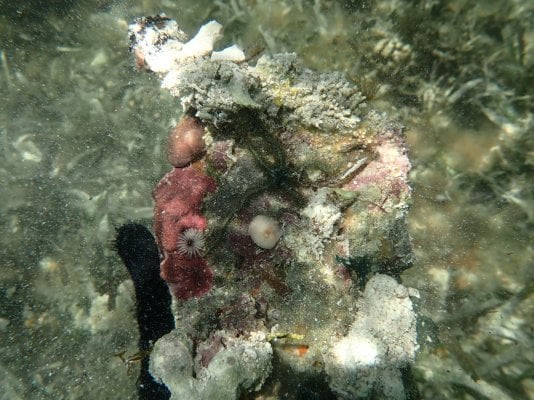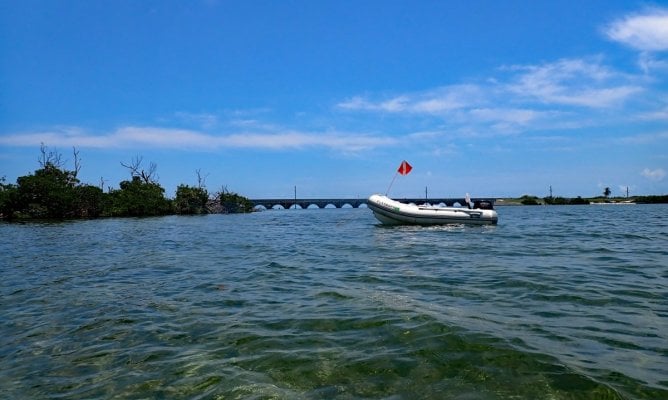Also one of my little pull off areas in the keys. There are also a couple of off shore reefs like coffins patch about 2 mile off marathon key.Sorry to reply so slowly, but we just got back from hiking in and around the Grand Canyon and the internet was VERY difficult to find!
I'm sure there are places to snorkel around Key West, but I've never done it. IMHO there are just too many people. The Horseshoe is a great place to snorkel and collect.
The inside is mostly deep water, but if you can free dive 15" or more, there are flame scallops and coral banded shrimp galore!
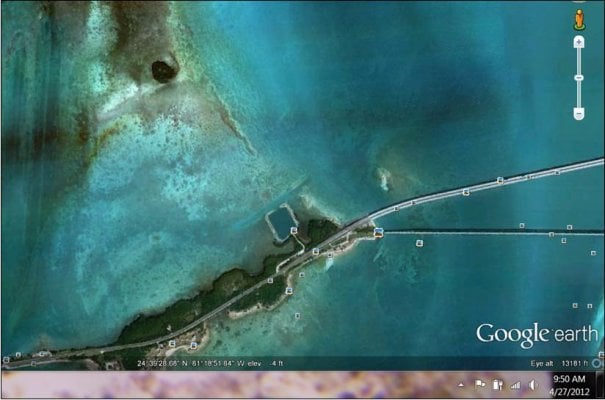
Out toward the open end of the quarry and along the inside edge to the left (SW) are the best areas. Picking up rocks to look under will get you to a lot of wildlife.

Also, there is now a walkway from the parking lot, around the NE end of the island (under the bridge) and out to a good snorkel site. But this one is far less protected against the prevailing SE wind, so it's only good on pretty calm days.
Have fun and now that I'm home, feel free to ask questions.
Navigation
Install the app
How to install the app on iOS
Follow along with the video below to see how to install our site as a web app on your home screen.
Note: This feature may not be available in some browsers.
More options
You are using an out of date browser. It may not display this or other websites correctly.
You should upgrade or use an alternative browser.
You should upgrade or use an alternative browser.
Snorkeling & Collecting Discussion Group
- Thread starter Ron Reefman
- Start date
- Tagged users None
A note before we start here. This will probably be a multi-part thread done ove a few days and with a LOT of photos... just so you are aware.
My wife and I just got back from 3 days of snorkeling in the Florida Keys, the Middle Keys to be specific. Wednesday it was sunny, warm and a bit windy, but visibility in the water was pretty good. Thursday it was sunny, warm and calmer winds. Friday we had a couple spotty showers in the early morning (which we just waited to pass) then sunny and very calm until midday when one bigger shower moved in. We had already been snorkeling for 90 minutes and decided to leave Little Money Key and headed back to the boat ramp, just to be safe. But by the time we got there, we (OK, I) could tell the shower was going to pass in a while and there was pretty clear skies moving in behind it. So we waited 20 minutes and then went back out to Little Money Key and did another 90 minutes of snorkeling! The sun warmed us up after the cool shower had both of us a bit chilly. It ended up being a really terrific 3 days. On the way home Saturday morning, the wind was so calm that the water was mirror flat! But we were already packed and headed home.
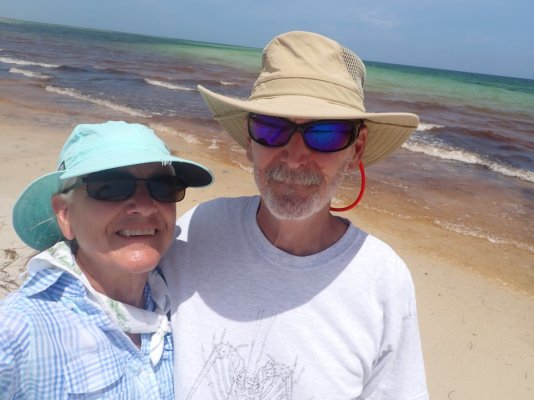
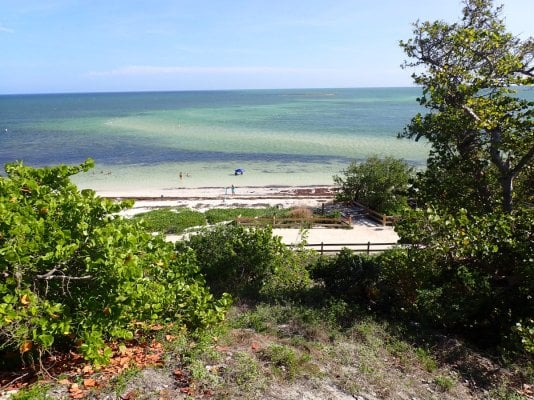
The day we arrived we went to Bahia Honda State Park and snorkeled off the ocean side beach. Day two we took the Zodiac and snorkeled in and around the Horseshoe on the Gulf side of Spanish Harbor Key. We didn't really need the Zodiac for this one, but I wanted it there just in case I wanted to get some distance away from the Horseshoe. Day three we used the Zodiac again and went to Little Money Key which has long been one of our all time favorite spots to snorkel.
I managed to collect all the CUC (Clean Up Crew) I wanted and a few I didn't expect, while Elaine took nearly 1000 photos.
Bahia Honda has been making slow but regular progress in it's recovery from Hurricane Irma. Sand Spur Beach was closed for over 4 years while lots of repairs were made. Now the facilities there and at the 2 other beaches are better than ever!
This is the beach we snorkel off of at the southwest end of the Key.
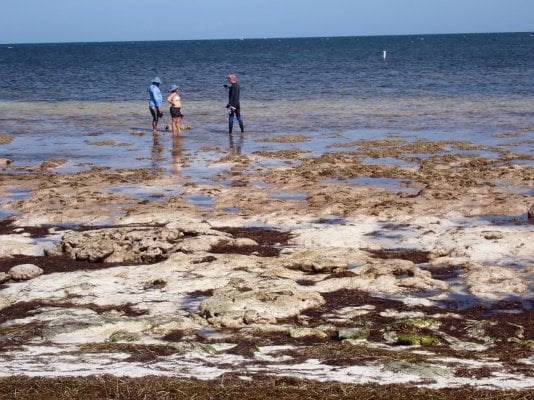
This is some of the just reopened Sandspur Beach. It's better for ocean side swimming than it is for snorkeling, but it can still be quite interesting.
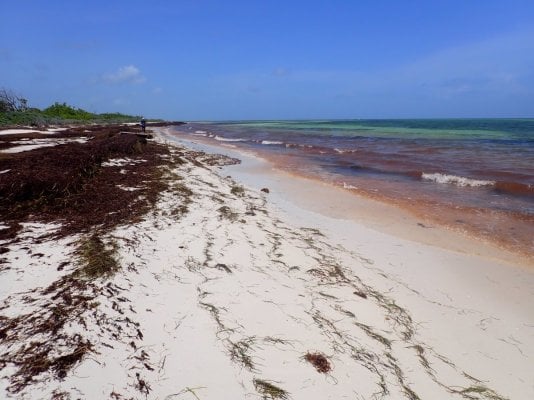
This is the terrific new bathrooms, changing rooms, showers facility at Sandspur Beach. BTW, the snorkeling beach has great new facilities as well!
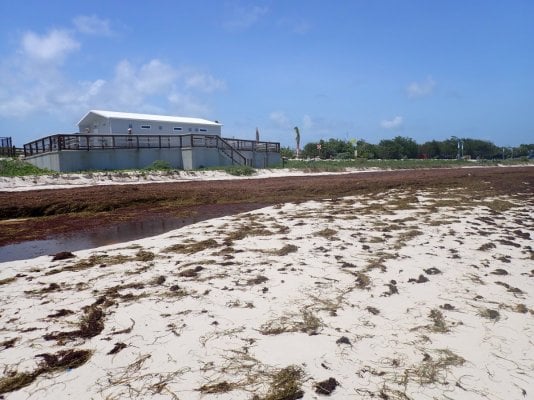

This is the more swimmer and family friendly beach on the Gulf side of the northwest end of the Key. These 2 beaches are all of 75 yards apart with a parking lot in between! The broken bridge in the background is the old Flagler Railroad Bridge.
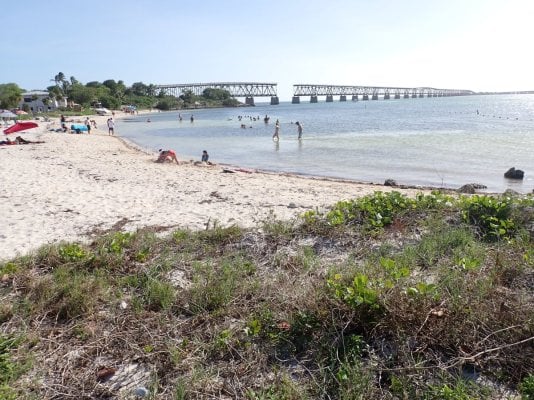
A sand sculpture at the small nature center/museum at the end of the Gulf side beach.
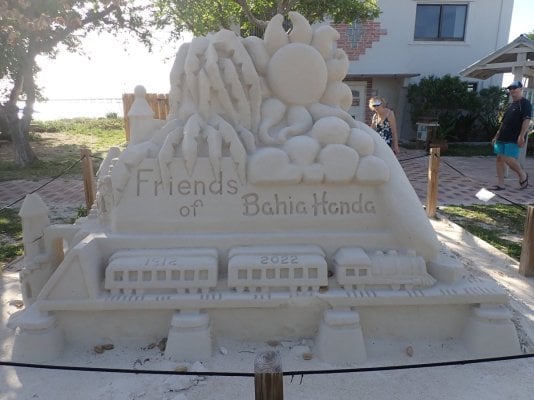
The one over arching thing we found on this trip (our first since our last trip a year ago) was that the underwater life has made quite a comeback since Hurricane Irma, 5 years ago! Even just a year ago, Bahia Honda was only showing some signs of recovery. So, we were surprised and happy to see lots of gorgonians, sponges and other animal life doing much better!
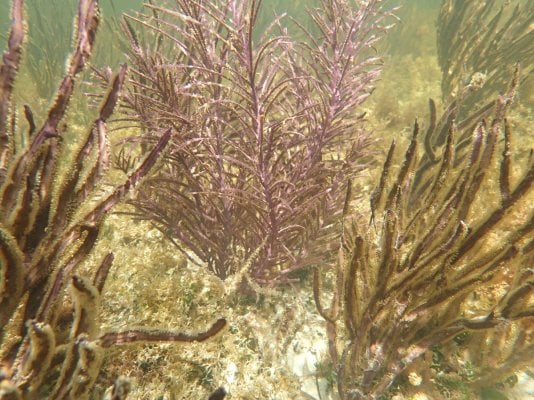
We even saw 6 different Flamingo Tongue snails which only eat gorgonians. But don't worry, there are millions of gorgonians and not very many Flamingo Tongue snails, so they don't really do any harm.
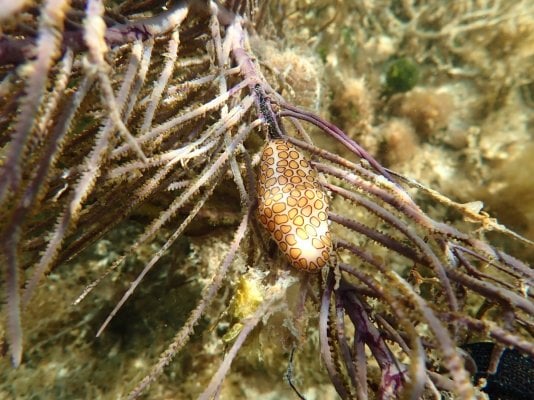
The great colors are NOT the shell, unfortunately. It is the snail's 'mantle' that it puts out and wraps around the shell. Typically this kind of coloration is to warn off potential predators that it may be harmful to eat. When they pull the mantle back in, the actual shell is very plain looking. You can see some of the shell here as the mantel is being retracted because we were getting too close.
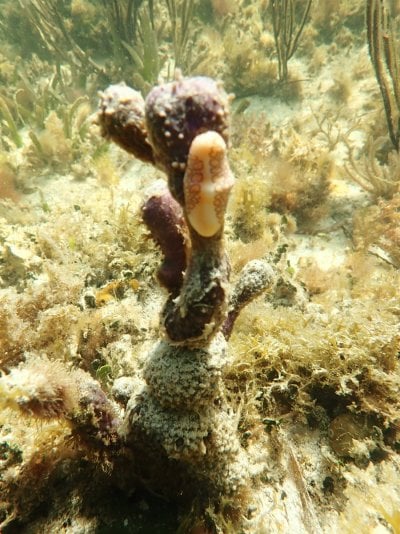
We saw emerald crabs, one was even a 'strawberry' version. We saw a cowfish, a few brown palys, lots of good size sponges and more. I can't tell you how glad we were to see things doing so well.
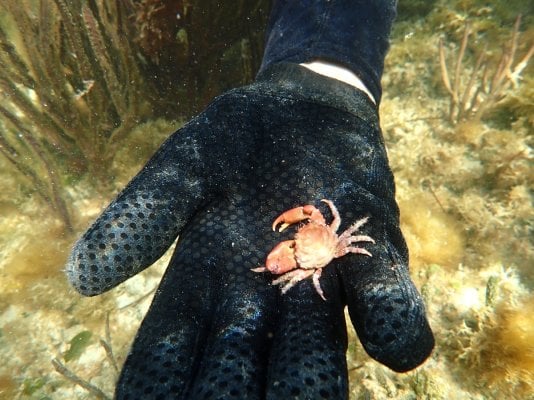
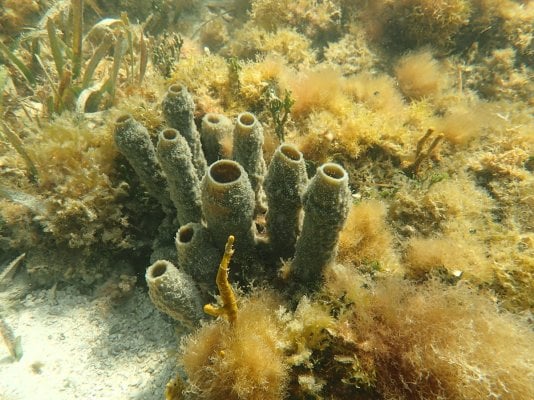
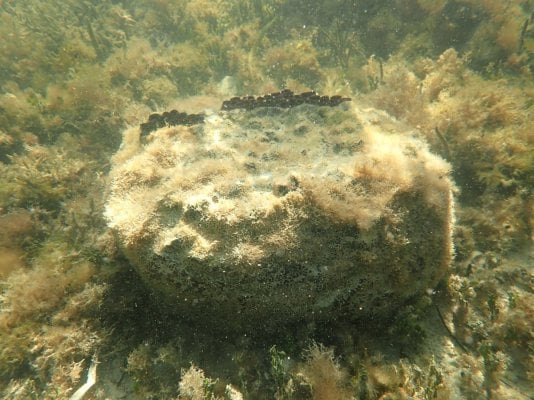
I'd recommend Bahia Honda State Park to anybody who wants to have some fun snorkeling right off the beach. The water is shallow, full of life (if you take the time to keep your eyes open and look) and user friendly. One caveat, the park does NOT clean the seaweed that washes in everyday. It can be kind of smelly, but your nose will get accustom to it. It's part of the ecosystem.
My wife and I just got back from 3 days of snorkeling in the Florida Keys, the Middle Keys to be specific. Wednesday it was sunny, warm and a bit windy, but visibility in the water was pretty good. Thursday it was sunny, warm and calmer winds. Friday we had a couple spotty showers in the early morning (which we just waited to pass) then sunny and very calm until midday when one bigger shower moved in. We had already been snorkeling for 90 minutes and decided to leave Little Money Key and headed back to the boat ramp, just to be safe. But by the time we got there, we (OK, I) could tell the shower was going to pass in a while and there was pretty clear skies moving in behind it. So we waited 20 minutes and then went back out to Little Money Key and did another 90 minutes of snorkeling! The sun warmed us up after the cool shower had both of us a bit chilly. It ended up being a really terrific 3 days. On the way home Saturday morning, the wind was so calm that the water was mirror flat! But we were already packed and headed home.


The day we arrived we went to Bahia Honda State Park and snorkeled off the ocean side beach. Day two we took the Zodiac and snorkeled in and around the Horseshoe on the Gulf side of Spanish Harbor Key. We didn't really need the Zodiac for this one, but I wanted it there just in case I wanted to get some distance away from the Horseshoe. Day three we used the Zodiac again and went to Little Money Key which has long been one of our all time favorite spots to snorkel.
I managed to collect all the CUC (Clean Up Crew) I wanted and a few I didn't expect, while Elaine took nearly 1000 photos.
Bahia Honda has been making slow but regular progress in it's recovery from Hurricane Irma. Sand Spur Beach was closed for over 4 years while lots of repairs were made. Now the facilities there and at the 2 other beaches are better than ever!
This is the beach we snorkel off of at the southwest end of the Key.

This is some of the just reopened Sandspur Beach. It's better for ocean side swimming than it is for snorkeling, but it can still be quite interesting.

This is the terrific new bathrooms, changing rooms, showers facility at Sandspur Beach. BTW, the snorkeling beach has great new facilities as well!


This is the more swimmer and family friendly beach on the Gulf side of the northwest end of the Key. These 2 beaches are all of 75 yards apart with a parking lot in between! The broken bridge in the background is the old Flagler Railroad Bridge.

A sand sculpture at the small nature center/museum at the end of the Gulf side beach.

The one over arching thing we found on this trip (our first since our last trip a year ago) was that the underwater life has made quite a comeback since Hurricane Irma, 5 years ago! Even just a year ago, Bahia Honda was only showing some signs of recovery. So, we were surprised and happy to see lots of gorgonians, sponges and other animal life doing much better!

We even saw 6 different Flamingo Tongue snails which only eat gorgonians. But don't worry, there are millions of gorgonians and not very many Flamingo Tongue snails, so they don't really do any harm.

The great colors are NOT the shell, unfortunately. It is the snail's 'mantle' that it puts out and wraps around the shell. Typically this kind of coloration is to warn off potential predators that it may be harmful to eat. When they pull the mantle back in, the actual shell is very plain looking. You can see some of the shell here as the mantel is being retracted because we were getting too close.

We saw emerald crabs, one was even a 'strawberry' version. We saw a cowfish, a few brown palys, lots of good size sponges and more. I can't tell you how glad we were to see things doing so well.



I'd recommend Bahia Honda State Park to anybody who wants to have some fun snorkeling right off the beach. The water is shallow, full of life (if you take the time to keep your eyes open and look) and user friendly. One caveat, the park does NOT clean the seaweed that washes in everyday. It can be kind of smelly, but your nose will get accustom to it. It's part of the ecosystem.
Last edited:
vetteguy53081
Well known Member and monster tank lover
View Badges
Partner Member 2024
Excellence Award
Reef Tank 365
RGB
Article Contributor
Tampa Bay Reef Keepers
West Palm Beach Reefer
Hospitality Award
Ocala Reef Club Member
305 Reef Club
Wisco Reefers
Midwest Reefer
Fish Medic
MAC of SW Florida
Rock Pool Reef Keepers
R2R Secret Santa 2023
My Tank Thread
My Aquarium Showcase
Beautiful picsA note before we start here. This will probably be a multi-part thread done ove a few days and with a LOT of photos... just so you are aware.
My wife and I just got back from 3 days of snorkeling in the Florida Keys, the Middle Keys to be specific. Wednesday it was sunny, warm and a bit windy, but visibility in the water was pretty good. Thursday it was sunny, warm and calmer winds. Friday we had a couple spotty showers in the early morning (which we just waited to pass) then sunny and very calm until midday when one bigger shower moved in. We had already been snorkeling for 90 minutes and decided to leave Little Money Key and headed back to the boat ramp, just to be safe. But by the time we got there, we (OK, I) could tell the shower was going to pass in a while and there was pretty clear skies moving in behind it. So we waited 20 minutes and then went back out to Little Money Key and did another 90 minutes of snorkeling! The sun warmed us up after the cool shower had both of us a bit chilly. It ended up being a really terrific 3 days. On the way home Saturday morning, the wind was so calm that the water was mirror flat! But we were already packed and headed home.


The day we arrived we went to Bahia Honda State Park and snorkeled off the ocean side beach. Day two we took the Zodiac and snorkeled in and around the Horseshoe on the Gulf side of Spanish Harbor Key. We didn't really need the Zodiac for this one, but I wanted it there just in case I wanted to get some distance away from the Horseshoe. Day three we used the Zodiac again and went to Little Money Key which has long been one of our all time favorite spots to snorkel.
I managed to collect all the CUC (Clean Up Crew) I wanted and a few I didn't expect, while Elaine took nearly 1000 photos.
Bahia Honda has been making slow but regular progress in it's recovery from Hurricane Irma. Sand Spur Beach was closed for over 4 years while lots of repairs were made. Now the facilities there and at the 2 other beaches are better than ever!
This is the beach we snorkel off of at the southwest end of the Key.

This is some of the just reopened Sandspur Beach. It's better for ocean side swimming than it is for snorkeling, but it can still be quite interesting.

This is the terrific new bathrooms, changing rooms, showers facility at Sandspur Beach. BTW, the snorkeling beach has great new facilities as well!


This is the more swimmer and family friendly beach on the Gulf side of the northwest end of the Key. These 2 beaches are all of 75 yards apart with a parking lot in between! The broken bridge in the background is the old Flagler Railroad Bridge.

A sand sculpture at the small nature center/museum at the end of the Gulf side beach.

The one over arching thing we found on this trip (our first since our last trip a year ago) was that the underwater life has made quite a comeback since Hurricane Irma, 5 years ago! Even just a year ago, Bahia Honda was only showing some signs of recovery. So, we were surprised and happy to see lots of gorgonians, sponges and other animal life doing much better!

We even saw 6 different Flamingo Tongue snails which only eat gorgonians. But don't worry, there are millions of gorgonians and not very many Flamingo Tongue snails, so they don't really do any harm.

The great colors are NOT the shell, unfortunately. It is the snail's 'mantle' that it puts out and wraps around the shell. Typically this kind of coloration is to warn off potential predators that it may be harmful to eat. When they pull the mantle back in, the actual shell is very plain looking. You can see some of the shell here as the mantel is being retracted because we were getting too close.

We saw emerald crabs, one was even a 'strawberry' version. We saw a cowfish, a few brown palys, lots of good size sponges and more. I can't tell you how glad we were to see things doing so well.



I'd recommend Bahia Honda State Park to anybody who wants to have some fun snorkeling right off the beach. The water is shallow, full of life (if you take the time to keep your eyes open and look) and user friendly. One caveat, the park does NOT clean the seaweed that washes in everyday. It can be kind of smelly, but your nose will get accustom to it. It's part of the ecosystem.
Lots more photos to come. Today I'll try and get post Day 2 stuff.Beautiful pics
Nick, if you ever have any questions, I'm happy to answer them. I have to admit, I'm a huge fan of snorkeling in the shallows. The big reefs are cool if you've never seen them. But they are all deeper water and totally protected. Shallow flats near shore are fun if you can enjoy finding uncommon small animals, seeing things more 'up close and personal' and even the ability to pick up 'stuff' to look at closer... maybe even collect a thing or two (with the proper license).
Like this guy...
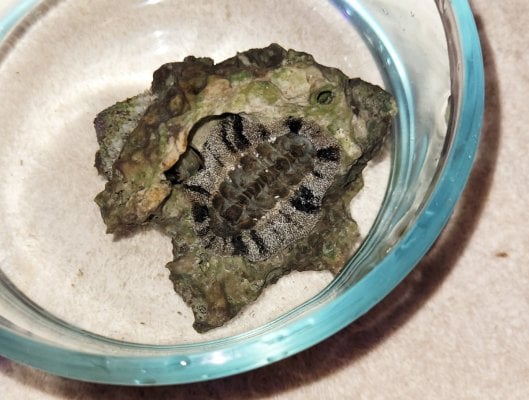
OK, on to Day 2.
The weather was better(i.e. less wind) but Friday was forecast to be even better. So we decided to do the Horseshoe today and save Little Money Key for Friday. The Horseshoe is better protected from the wind 95% of the time. Here is a high altitude shot and a closer shot, and you can clearly see why they call it the Horseshoe.
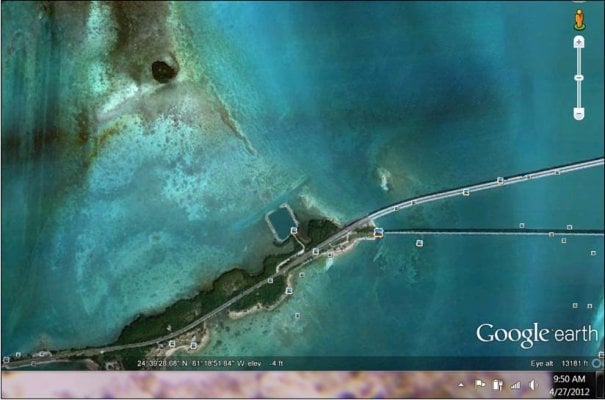
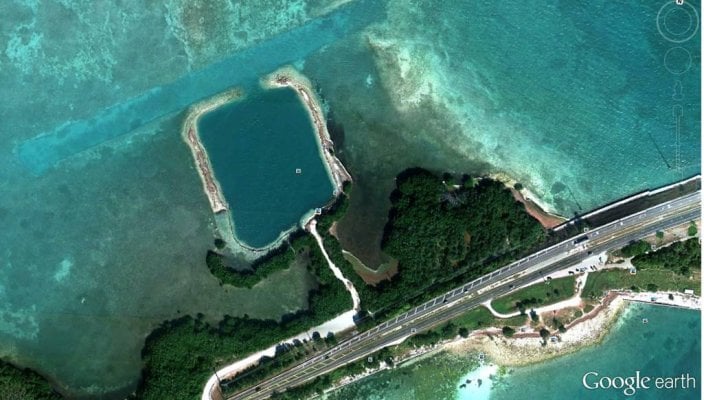
It was just past a full moon and we were close to high tide by the time we arrived. The arms that make up the outside edge of the quarry are exposed way more often than under water. But today they were well under.
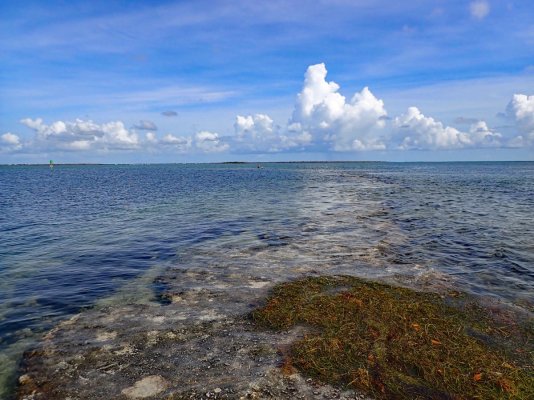
That meant to me that nerite snails might be up on the top of the arm... and they were. This is me picking up a few nerites just as soon as I stepped out of the Zodiac. BTW, notice the white lid to my collecting container. I set it down as if the walkway were dry and didn't pay attention. Over the next few minutes it drifted away and I never found it!
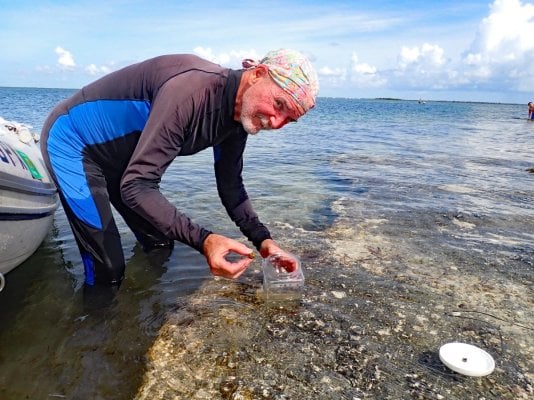
We snorkeled out the inside of the right arm to the end and crossed over the channel to the inside of the left arm of the Horseshoe. I've never found much to collect along the inside of the right arm. But this time I was looking for smalls since I only have a 16g tank now. As I got out toward the end of the arm I found a very nice yellow sea cucumber that I think is small enough for my tank.
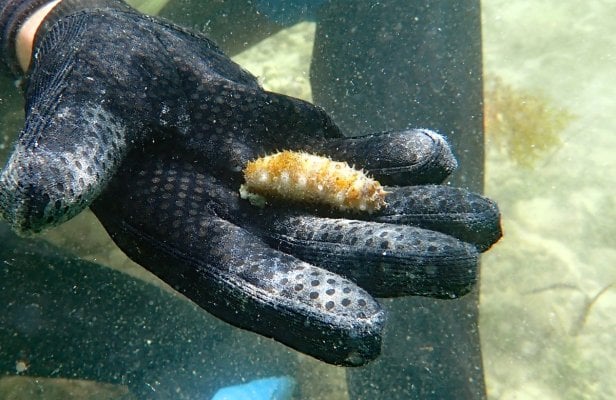
As we rounded the bend at the top of the arm, there were several people fishing off the outside. I normally like to go out there because there seems to always be more to see, especially astrea snails and sea stars. But I didn't want to disturb the people fishing. I did find a good size Tulip snail that I'm 99% sure was eating a big astrea snail!
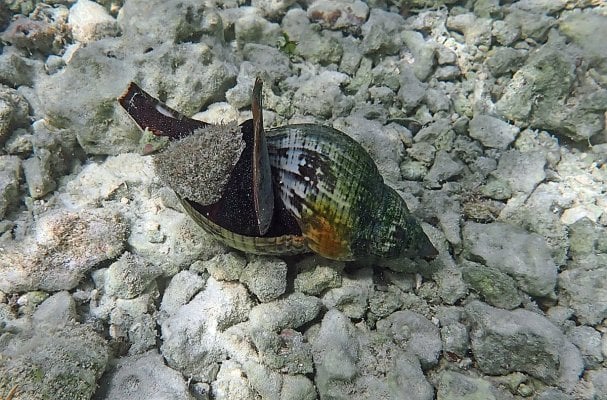
A little further along I picked up a fairly small rock, not expecting much. To my surprise, a mantis shrimp hung onto the rock for a bit and then let go. They can move super fast when on the bottom and we rarely see them for more than a few seconds. But this one let go of the rock and was slowly sinking toward the bottom. I caught it in one hand and had to struggle for a while to gain some control. I ended up just keeping it up off the bottom until I got my container ready (now inside a fine net bag since I lost the lid...). I opened the net bag and let the shrimp just sink into it. It was super easy. But the reality is, that's the first time that a mantis shrimp ever held onto the rock rather than scampering over and under the rocks.
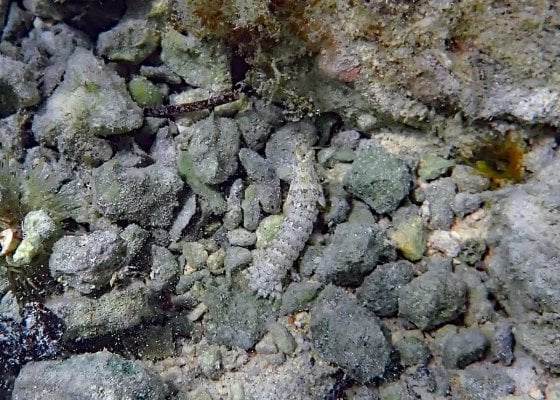
It's home with me now and I have to decide just what I want to do with it. So far I haven't seen that it has caused any issues with the other livestock in the holding tank.
Elaine found a really nice juvenile queen conch. We've never seen many queen conch inside the Horseshoe, so this was a bit unusual as well.

They have installed new signs and markers along the boat channel just off the outside end of the Horseshoe and even a sign to those of us playing inside the Horseshoe to warn us about the fact that there is a boat channel just outside. At a normal low tide this might still be in the water. But at an extreme low tide this is probably in the rocks just above the surface.
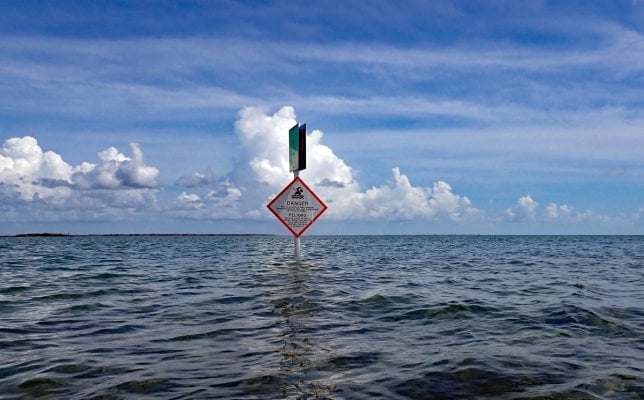
The far end of the left arm on the inside seems to always have more sea creatures. Almost as soon as we had crossed the channel we found this good size clump of a bright yellow stony coral. There is always some small finger corals around, but this is a different species and we don't see it inshore snorkeling all that often. Two points to anybody who is interested: First, ALL stony corals are illegal to collect in Florida without a special permit, and getting caught with it is a huge fine (likely $1000+ for this coral) and you don't get to keep the coral! Second, I'm 99% sure this coral is not photosynthetic and would die on almost any reef tank.
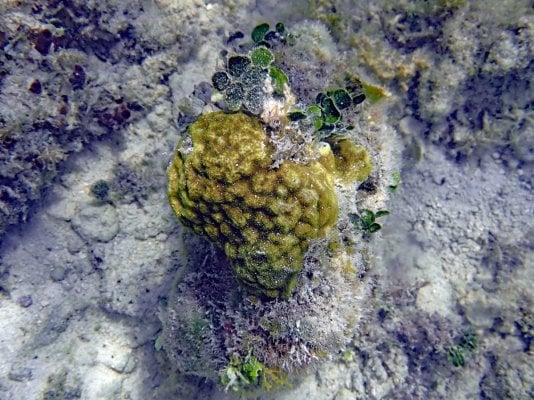
This side of the Horseshoe, and especially the outside of the left arm is a haven for urchins. Elaine found this one and took a photo, but she could have taken a dozen more just as easily. I don't have a sump anymore, which is where I would keep an urchin. And I find them to be bulldozers in a DT with coral. So none for me this trip.
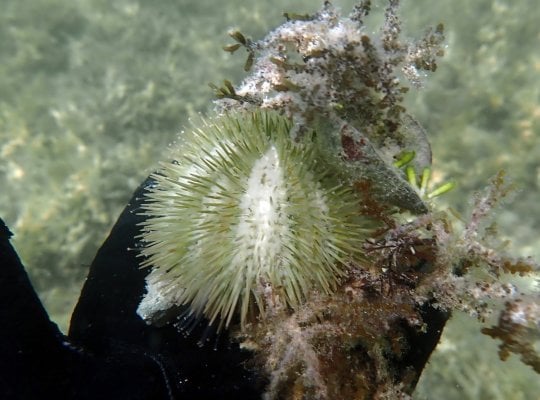
As we started to head back toward shore along the inside of the left arm we started finding some sea stars. I wanted 1 or 2 small ones. I ended up with 2 serpent stars; 1 small and 1 medium small. The photos below are not the ones I collected, these are ones Elaine saw and photographed. The one on the left is known as a serpent star and the one on the right is known as a brittle star. The brittle star has the 'spines' along its arms and IMHO the arms do break off easier.
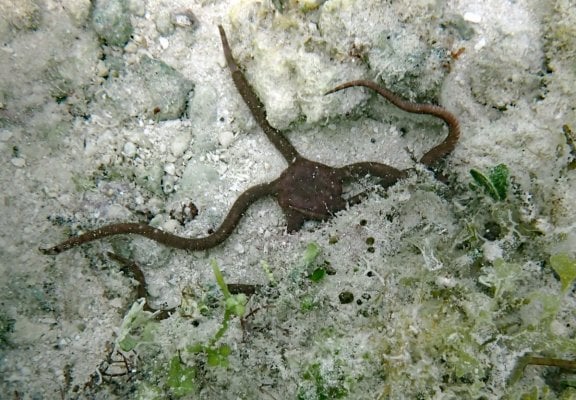
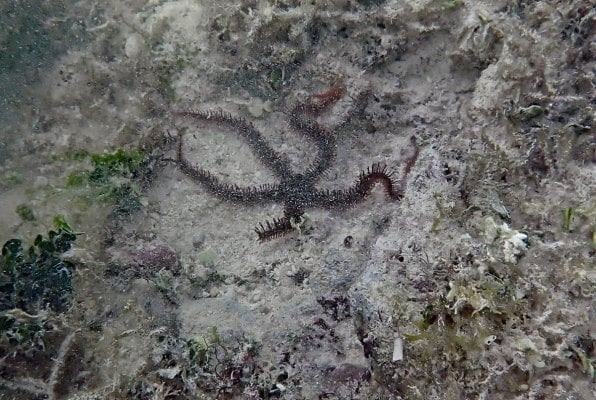
We saw a couple of bigger swimmer crabs. This one was about 4 to 5 inches from shoulder to shoulder.
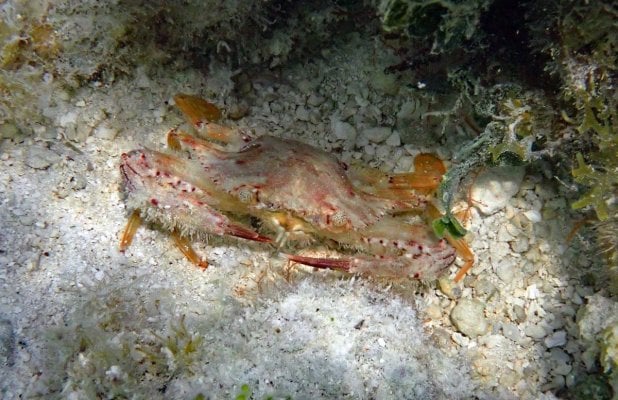
Elaine also found a cowrie shell that was in 'mint' condition, although it was a bit smaller than ones we had collected before. She had me put it in with my livestock until we got back to the Zodiac. I was showing somebody what we had collected and pulled out this shell, intending to give it to Elaine. But wait... the cowrie was still alive, so we moved it out away from the outside of the Horseshoe in a grassy flat.
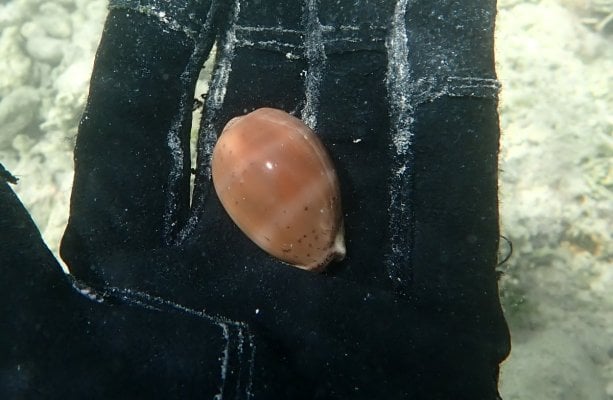
I've found some astrea snails along this side before. But today was amazing. I could easily have collected more than a hundred without even trying very hard. I did take what I wanted for my small tank, but I was very surprised at the total number of them. Heck, there are 4 or 5 in this photo Elaine took of one rock!
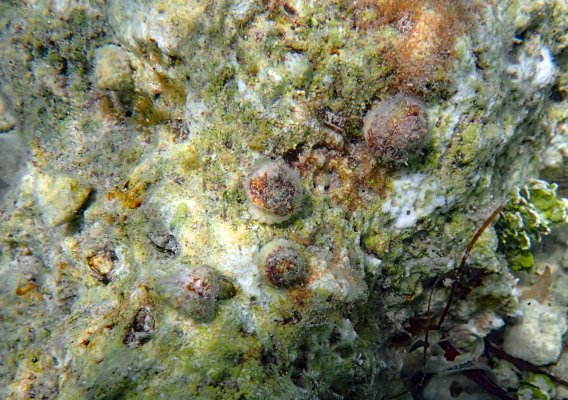
Now, if you know what this is, I'll consider you a fairly knowledgeable reefer. This is not a fossil. Although they often do end up above the water surface stuck like glue to a rock. I actually showed the one I collected to a guy and he asked why I was collecting a fossil? It's a mollusk with a segmented shell (always 8 segments). Its called a chiton and there are over 600 species around the world. I got one of these as well as 2 more that are a different species. I'll have a photo of them at the end where I show off all that I collected.
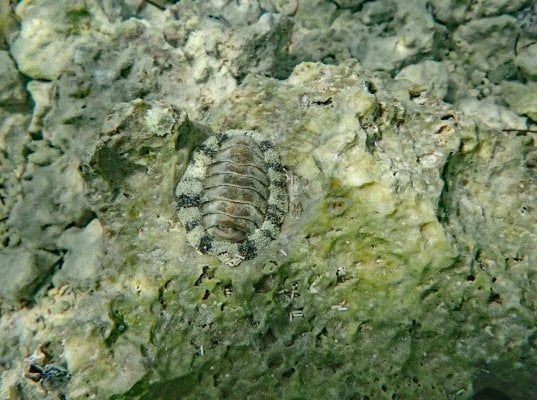
If you encounter one of these, stay clear. This is a fire worm and the fuzzy white on its back are spines that will stick in your skin worse than any cactus I've ever dealt with. These guys are typically 6 to 8 inches long and hide by being attached to the underside of loose rocks. This is the biggest reason I wear dive gloves.
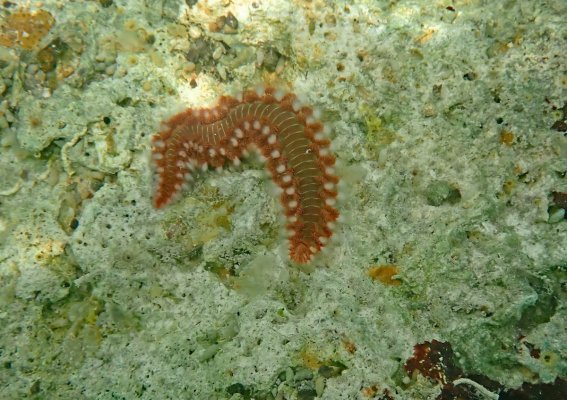
As you get close to shore on this side of the Shoe, the arm becomes individual big rocks or boulders. If you want to try and collect a fish, this might be the place to try it. I've pretty much given it up as a hopeless task. Although this time I did see a really tiny Sargent Major, maybe 1" long, that didn't seem to be afraid of me. I think if I had my net, I might have caught it... naw! I've seen juvenile tangs and some butterflyfish here as well. But there are always lots of bigger fish here.
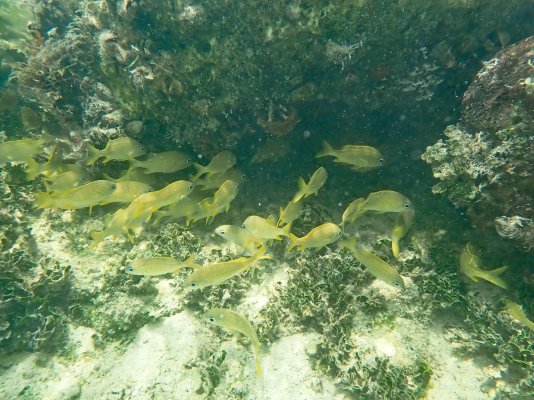
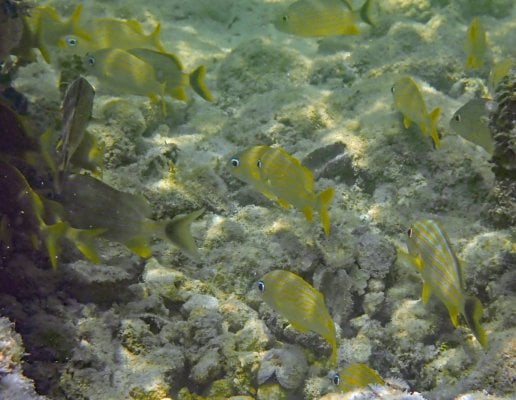
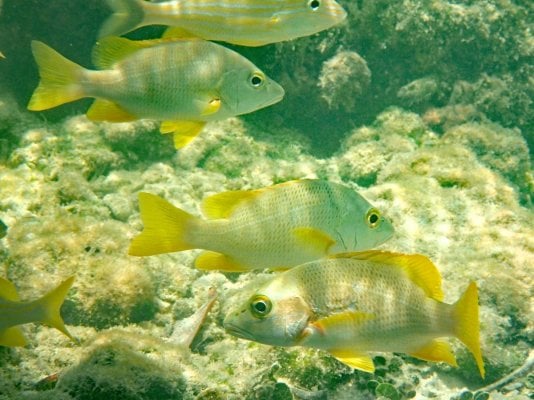
If you stand up and look over the rocks toward shore this is the view.
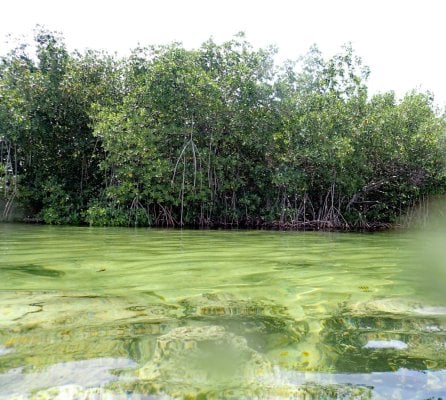
And in the past there have always been quite a few, as in dozens and dozens, of upside down jellyfish just a few yards further away from shore. I've been in among them before, but didn't go outside the Horseshoe on that side this trip. The jellyfish do sting if the touch your skin, but the tentacle are short and they basically lay up side down on the sandy bottom and don't bother with you swimming by.
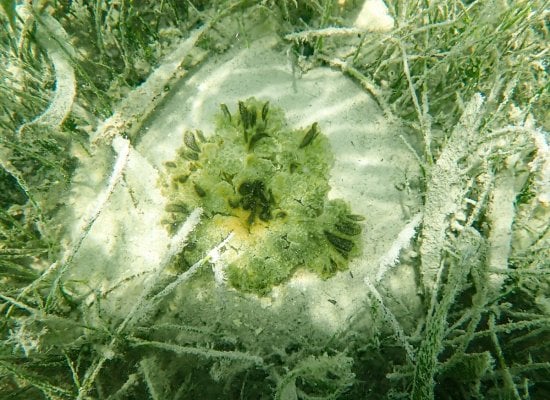
Later I get up the second half of Day 2 which was outside the right side of the Horseshoe.
The weather was better(i.e. less wind) but Friday was forecast to be even better. So we decided to do the Horseshoe today and save Little Money Key for Friday. The Horseshoe is better protected from the wind 95% of the time. Here is a high altitude shot and a closer shot, and you can clearly see why they call it the Horseshoe.


It was just past a full moon and we were close to high tide by the time we arrived. The arms that make up the outside edge of the quarry are exposed way more often than under water. But today they were well under.

That meant to me that nerite snails might be up on the top of the arm... and they were. This is me picking up a few nerites just as soon as I stepped out of the Zodiac. BTW, notice the white lid to my collecting container. I set it down as if the walkway were dry and didn't pay attention. Over the next few minutes it drifted away and I never found it!

We snorkeled out the inside of the right arm to the end and crossed over the channel to the inside of the left arm of the Horseshoe. I've never found much to collect along the inside of the right arm. But this time I was looking for smalls since I only have a 16g tank now. As I got out toward the end of the arm I found a very nice yellow sea cucumber that I think is small enough for my tank.

As we rounded the bend at the top of the arm, there were several people fishing off the outside. I normally like to go out there because there seems to always be more to see, especially astrea snails and sea stars. But I didn't want to disturb the people fishing. I did find a good size Tulip snail that I'm 99% sure was eating a big astrea snail!

A little further along I picked up a fairly small rock, not expecting much. To my surprise, a mantis shrimp hung onto the rock for a bit and then let go. They can move super fast when on the bottom and we rarely see them for more than a few seconds. But this one let go of the rock and was slowly sinking toward the bottom. I caught it in one hand and had to struggle for a while to gain some control. I ended up just keeping it up off the bottom until I got my container ready (now inside a fine net bag since I lost the lid...). I opened the net bag and let the shrimp just sink into it. It was super easy. But the reality is, that's the first time that a mantis shrimp ever held onto the rock rather than scampering over and under the rocks.

It's home with me now and I have to decide just what I want to do with it. So far I haven't seen that it has caused any issues with the other livestock in the holding tank.
Elaine found a really nice juvenile queen conch. We've never seen many queen conch inside the Horseshoe, so this was a bit unusual as well.

They have installed new signs and markers along the boat channel just off the outside end of the Horseshoe and even a sign to those of us playing inside the Horseshoe to warn us about the fact that there is a boat channel just outside. At a normal low tide this might still be in the water. But at an extreme low tide this is probably in the rocks just above the surface.

The far end of the left arm on the inside seems to always have more sea creatures. Almost as soon as we had crossed the channel we found this good size clump of a bright yellow stony coral. There is always some small finger corals around, but this is a different species and we don't see it inshore snorkeling all that often. Two points to anybody who is interested: First, ALL stony corals are illegal to collect in Florida without a special permit, and getting caught with it is a huge fine (likely $1000+ for this coral) and you don't get to keep the coral! Second, I'm 99% sure this coral is not photosynthetic and would die on almost any reef tank.

This side of the Horseshoe, and especially the outside of the left arm is a haven for urchins. Elaine found this one and took a photo, but she could have taken a dozen more just as easily. I don't have a sump anymore, which is where I would keep an urchin. And I find them to be bulldozers in a DT with coral. So none for me this trip.

As we started to head back toward shore along the inside of the left arm we started finding some sea stars. I wanted 1 or 2 small ones. I ended up with 2 serpent stars; 1 small and 1 medium small. The photos below are not the ones I collected, these are ones Elaine saw and photographed. The one on the left is known as a serpent star and the one on the right is known as a brittle star. The brittle star has the 'spines' along its arms and IMHO the arms do break off easier.


We saw a couple of bigger swimmer crabs. This one was about 4 to 5 inches from shoulder to shoulder.

Elaine also found a cowrie shell that was in 'mint' condition, although it was a bit smaller than ones we had collected before. She had me put it in with my livestock until we got back to the Zodiac. I was showing somebody what we had collected and pulled out this shell, intending to give it to Elaine. But wait... the cowrie was still alive, so we moved it out away from the outside of the Horseshoe in a grassy flat.

I've found some astrea snails along this side before. But today was amazing. I could easily have collected more than a hundred without even trying very hard. I did take what I wanted for my small tank, but I was very surprised at the total number of them. Heck, there are 4 or 5 in this photo Elaine took of one rock!

Now, if you know what this is, I'll consider you a fairly knowledgeable reefer. This is not a fossil. Although they often do end up above the water surface stuck like glue to a rock. I actually showed the one I collected to a guy and he asked why I was collecting a fossil? It's a mollusk with a segmented shell (always 8 segments). Its called a chiton and there are over 600 species around the world. I got one of these as well as 2 more that are a different species. I'll have a photo of them at the end where I show off all that I collected.

If you encounter one of these, stay clear. This is a fire worm and the fuzzy white on its back are spines that will stick in your skin worse than any cactus I've ever dealt with. These guys are typically 6 to 8 inches long and hide by being attached to the underside of loose rocks. This is the biggest reason I wear dive gloves.

As you get close to shore on this side of the Shoe, the arm becomes individual big rocks or boulders. If you want to try and collect a fish, this might be the place to try it. I've pretty much given it up as a hopeless task. Although this time I did see a really tiny Sargent Major, maybe 1" long, that didn't seem to be afraid of me. I think if I had my net, I might have caught it... naw! I've seen juvenile tangs and some butterflyfish here as well. But there are always lots of bigger fish here.



If you stand up and look over the rocks toward shore this is the view.

And in the past there have always been quite a few, as in dozens and dozens, of upside down jellyfish just a few yards further away from shore. I've been in among them before, but didn't go outside the Horseshoe on that side this trip. The jellyfish do sting if the touch your skin, but the tentacle are short and they basically lay up side down on the sandy bottom and don't bother with you swimming by.

Later I get up the second half of Day 2 which was outside the right side of the Horseshoe.
Horseshoe cove is one of my favorites for the family to search.OK, on to Day 2.
The weather was better(i.e. less wind) but Friday was forecast to be even better. So we decided to do the Horseshoe today and save Little Money Key for Friday. The Horseshoe is better protected from the wind 95% of the time. Here is a high altitude shot and a closer shot, and you can clearly see why they call it the Horseshoe.


It was just past a full moon and we were close to high tide by the time we arrived. The arms that make up the outside edge of the quarry are exposed way more often than under water. But today they were well under.

That meant to me that nerite snails might be up on the top of the arm... and they were. This is me picking up a few nerites just as soon as I stepped out of the Zodiac. BTW, notice the white lid to my collecting container. I set it down as if the walkway were dry and didn't pay attention. Over the next few minutes it drifted away and I never found it!

We snorkeled out the inside of the right arm to the end and crossed over the channel to the inside of the left arm of the Horseshoe. I've never found much to collect along the inside of the right arm. But this time I was looking for smalls since I only have a 16g tank now. As I got out toward the end of the arm I found a very nice yellow sea cucumber that I think is small enough for my tank.

As we rounded the bend at the top of the arm, there were several people fishing off the outside. I normally like to go out there because there seems to always be more to see, especially astrea snails and sea stars. But I didn't want to disturb the people fishing. I did find a good size Tulip snail that I'm 99% sure was eating a big astrea snail!

A little further along I picked up a fairly small rock, not expecting much. To my surprise, a mantis shrimp hung onto the rock for a bit and then let go. They can move super fast when on the bottom and we rarely see them for more than a few seconds. But this one let go of the rock and was slowly sinking toward the bottom. I caught it in one hand and had to struggle for a while to gain some control. I ended up just keeping it up off the bottom until I got my container ready (now inside a fine net bag since I lost the lid...). I opened the net bag and let the shrimp just sink into it. It was super easy. But the reality is, that's the first time that a mantis shrimp ever held onto the rock rather than scampering over and under the rocks.

It's home with me now and I have to decide just what I want to do with it. So far I haven't seen that it has caused any issues with the other livestock in the holding tank.
Elaine found a really nice juvenile queen conch. We've never seen many queen conch inside the Horseshoe, so this was a bit unusual as well.

They have installed new signs and markers along the boat channel just off the outside end of the Horseshoe and even a sign to those of us playing inside the Horseshoe to warn us about the fact that there is a boat channel just outside. At a normal low tide this might still be in the water. But at an extreme low tide this is probably in the rocks just above the surface.

The far end of the left arm on the inside seems to always have more sea creatures. Almost as soon as we had crossed the channel we found this good size clump of a bright yellow stony coral. There is always some small finger corals around, but this is a different species and we don't see it inshore snorkeling all that often. Two points to anybody who is interested: First, ALL stony corals are illegal to collect in Florida without a special permit, and getting caught with it is a huge fine (likely $1000+ for this coral) and you don't get to keep the coral! Second, I'm 99% sure this coral is not photosynthetic and would die on almost any reef tank.

This side of the Horseshoe, and especially the outside of the left arm is a haven for urchins. Elaine found this one and took a photo, but she could have taken a dozen more just as easily. I don't have a sump anymore, which is where I would keep an urchin. And I find them to be bulldozers in a DT with coral. So none for me this trip.

As we started to head back toward shore along the inside of the left arm we started finding some sea stars. I wanted 1 or 2 small ones. I ended up with 2 serpent stars; 1 small and 1 medium small. The photos below are not the ones I collected, these are ones Elaine saw and photographed. The one on the left is known as a serpent star and the one on the right is known as a brittle star. The brittle star has the 'spines' along its arms and IMHO the arms do break off easier.


We saw a couple of bigger swimmer crabs. This one was about 4 to 5 inches from shoulder to shoulder.

Elaine also found a cowrie shell that was in 'mint' condition, although it was a bit smaller than ones we had collected before. She had me put it in with my livestock until we got back to the Zodiac. I was showing somebody what we had collected and pulled out this shell, intending to give it to Elaine. But wait... the cowrie was still alive, so we moved it out away from the outside of the Horseshoe in a grassy flat.

I've found some astrea snails along this side before. But today was amazing. I could easily have collected more than a hundred without even trying very hard. I did take what I wanted for my small tank, but I was very surprised at the total number of them. Heck, there are 4 or 5 in this photo Elaine took of one rock!

Now, if you know what this is, I'll consider you a fairly knowledgeable reefer. This is not a fossil. Although they often do end up above the water surface stuck like glue to a rock. I actually showed the one I collected to a guy and he asked why I was collecting a fossil? It's a mollusk with a segmented shell (always 8 segments). Its called a chiton and there are over 600 species around the world. I got one of these as well as 2 more that are a different species. I'll have a photo of them at the end where I show off all that I collected.

If you encounter one of these, stay clear. This is a fire worm and the fuzzy white on its back are spines that will stick in your skin worse than any cactus I've ever dealt with. These guys are typically 6 to 8 inches long and hide by being attached to the underside of loose rocks. This is the biggest reason I wear dive gloves.

As you get close to shore on this side of the Shoe, the arm becomes individual big rocks or boulders. If you want to try and collect a fish, this might be the place to try it. I've pretty much given it up as a hopeless task. Although this time I did see a really tiny Sargent Major, maybe 1" long, that didn't seem to be afraid of me. I think if I had my net, I might have caught it... naw! I've seen juvenile tangs and some butterflyfish here as well. But there are always lots of bigger fish here.



If you stand up and look over the rocks toward shore this is the view.

And in the past there have always been quite a few, as in dozens and dozens, of upside down jellyfish just a few yards further away from shore. I've been in among them before, but didn't go outside the Horseshoe on that side this trip. The jellyfish do sting if the touch your skin, but the tentacle are short and they basically lay up side down on the sandy bottom and don't bother with you swimming by.

Later I get up the second half of Day 2 which was outside the right side of the Horseshoe.
Day 2... after lunch
As we usually do, lunch in the Zodiac is a PB&J and some watermelon. I'm not sure why, but watermelon really tastes good after being in the water for a couple of hours! The Shoe was getting kind of full, and lots of them were kids who just scare the sea creatures with all their splashing and fast movements. So we ventured out to the outside of the right arm of the shoe. There is a slope of rocks and then a big field of turtle grass, all at about 3' deep near high tide. There isn't much to see in the grass, so we moved far enough to the northeast to get beyond the grass and find some sandy bottom.
Elaine loves the queen conch and we found a few more out here. The really good news compared to a couple of years ago is, ever shell we found out here had a live conch inside!
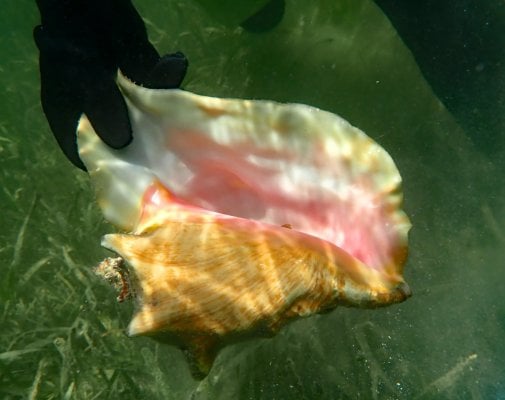
I always find the hard coraline algae that grows on it's own and forms a mass to be really interesting. I guess it has to grow somewhere because there aren't any glass walls out here for it to grow on like it does in my tank! It mostly seems to be in water that moves some and has bright sunshine.
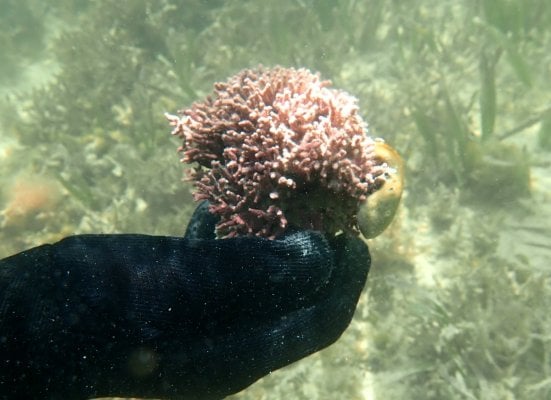
Of course Elaine is always trying to get good shots of fish almost whenever she sees them. And the colorful young damsel fish always make a good show. Because if you are near there home turf, they are willing to swim up to you and try to get you to move away.
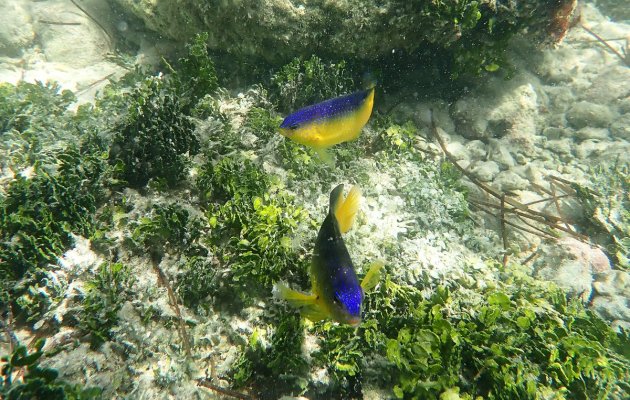
As we looped around and moved out a bit further from shore, I found an old trap (stone crab I think, but it could be a lobster trap?). I opened the top and to my surprise there were a bunch of small fish and one big Condy anemone. If I had wanted to catch fish, this would almost have been like "shooting fish in a barrel" easy. They could swim out through the slats of the trap, but there were enough of them in there That I think I'd have netted at least 1 or 2.
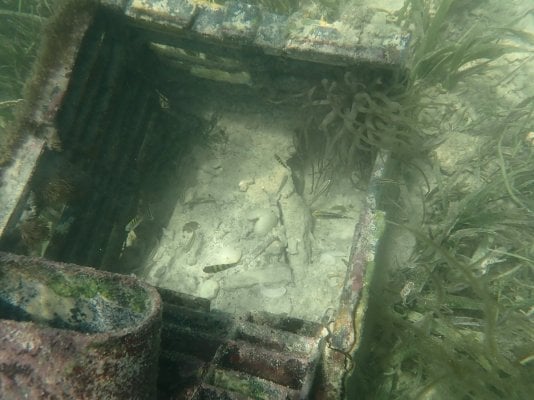
And this was the only Condy we saw during all 3 days. We used to see them quite a bit. And back before them became protected, I brought a couple home. I don't know if it's over collection, environmental issues or disease that has the population under threat. This one wasn't colorful at all, but then it was living in a fairly dark environment inside the trap with a solid lid.
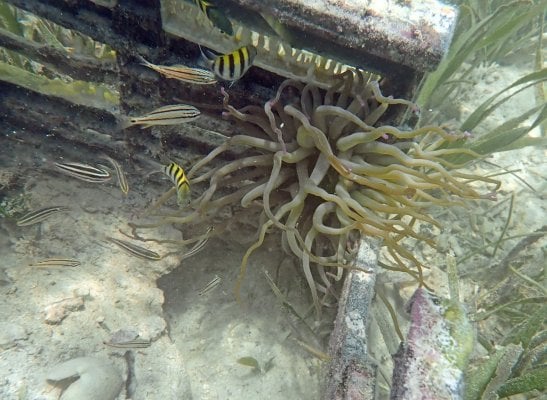
As we got back to the rocky bank along the outside of the Shoe, I found another pretty crab.
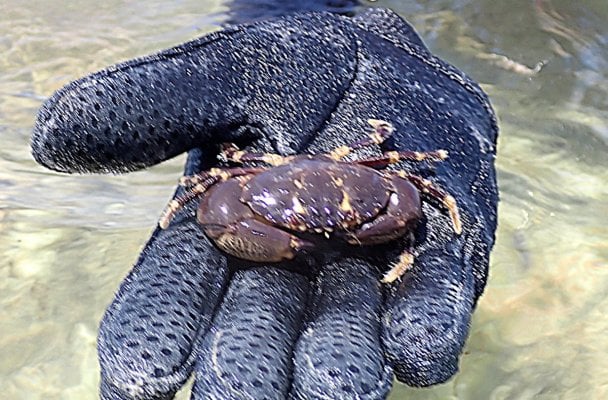
We also found these rocks to be teaming with emerald crabs. You could hardly pick up a rock and not find at least on crab! I took 2 small ones for my tank.
Back at the boat, Elaine took a selfie and you can see behind her that the tide was going out and now the top of the arm was above the water surface.
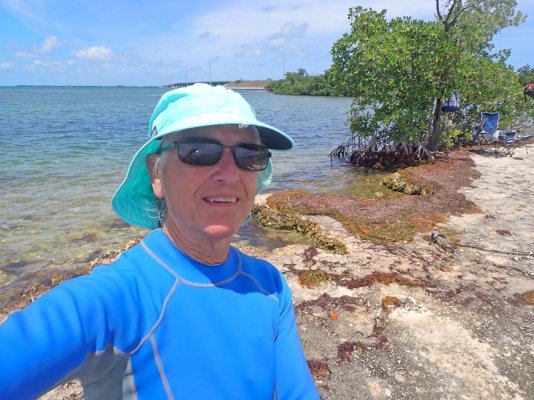
There was a young guy (high school age) that was doing some collecting of his own. But he was using very different techniques that we were. He wore a mask and snorkel, but stood up, walked around or knelt down rather than swimming. And he spent all of his time out at the far end of the right arm on the outside. This is very near where the people were fishing that I didn't want to disturb. Here is what he caught.
This is a sea hare. He had 2. One was considerably bigger and while he was carrying it to his holding container, it inked him and his hand was very purple!
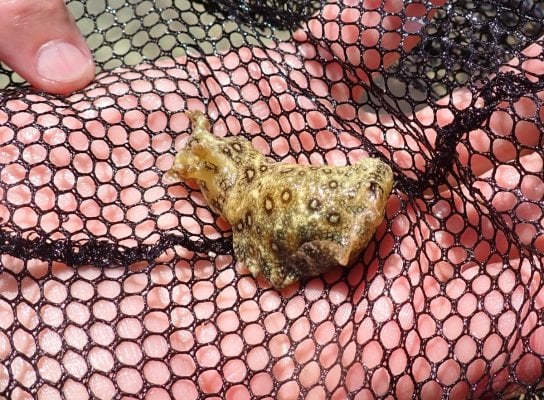
We've seen some of these, despite that fact that them camouflage into the bottom so well. This is a scorpionfish, also known as a rockfish or a stonefish.
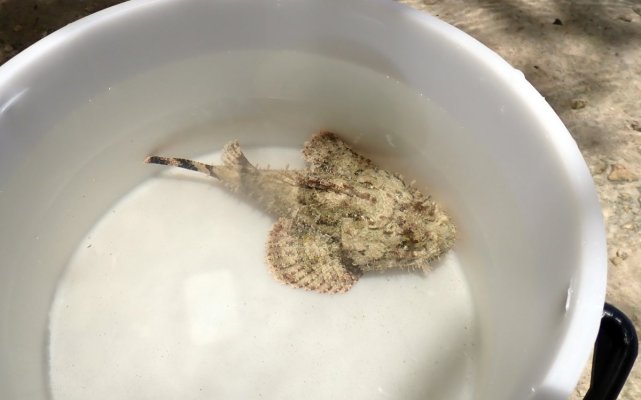
At the end of our day, the tide was going out fast, but we were still 2 or 3 hours from low tide. And this is how dry the right side arm of the Horseshoe can get! The dry surface at the lower right of this photo is the exact same spot were I was picking up nerite snails when we first arrived. But this shot looks in toward shore, the shot of me picking up nerites is looking out into the Gulf of Mexico.
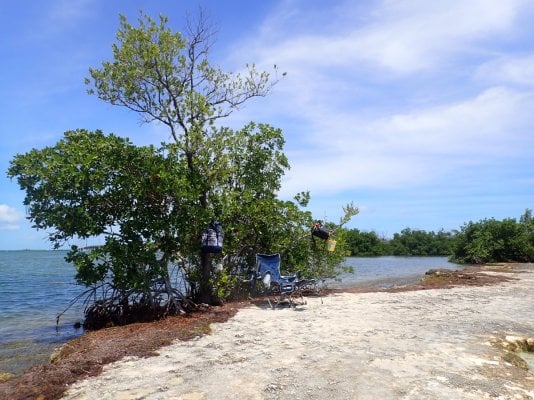
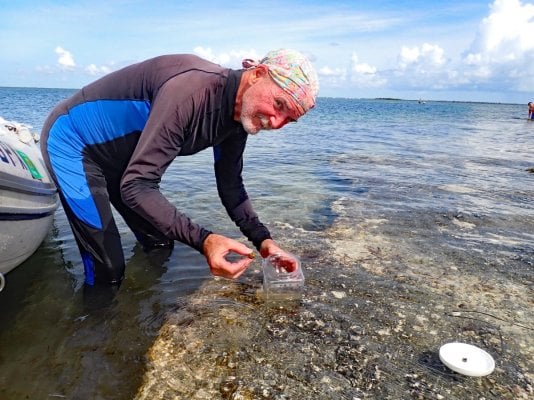
Day 3 will probably get done tomorrow and then a review of our collection.
As we usually do, lunch in the Zodiac is a PB&J and some watermelon. I'm not sure why, but watermelon really tastes good after being in the water for a couple of hours! The Shoe was getting kind of full, and lots of them were kids who just scare the sea creatures with all their splashing and fast movements. So we ventured out to the outside of the right arm of the shoe. There is a slope of rocks and then a big field of turtle grass, all at about 3' deep near high tide. There isn't much to see in the grass, so we moved far enough to the northeast to get beyond the grass and find some sandy bottom.
Elaine loves the queen conch and we found a few more out here. The really good news compared to a couple of years ago is, ever shell we found out here had a live conch inside!

I always find the hard coraline algae that grows on it's own and forms a mass to be really interesting. I guess it has to grow somewhere because there aren't any glass walls out here for it to grow on like it does in my tank! It mostly seems to be in water that moves some and has bright sunshine.

Of course Elaine is always trying to get good shots of fish almost whenever she sees them. And the colorful young damsel fish always make a good show. Because if you are near there home turf, they are willing to swim up to you and try to get you to move away.

As we looped around and moved out a bit further from shore, I found an old trap (stone crab I think, but it could be a lobster trap?). I opened the top and to my surprise there were a bunch of small fish and one big Condy anemone. If I had wanted to catch fish, this would almost have been like "shooting fish in a barrel" easy. They could swim out through the slats of the trap, but there were enough of them in there That I think I'd have netted at least 1 or 2.

And this was the only Condy we saw during all 3 days. We used to see them quite a bit. And back before them became protected, I brought a couple home. I don't know if it's over collection, environmental issues or disease that has the population under threat. This one wasn't colorful at all, but then it was living in a fairly dark environment inside the trap with a solid lid.

As we got back to the rocky bank along the outside of the Shoe, I found another pretty crab.

We also found these rocks to be teaming with emerald crabs. You could hardly pick up a rock and not find at least on crab! I took 2 small ones for my tank.
Back at the boat, Elaine took a selfie and you can see behind her that the tide was going out and now the top of the arm was above the water surface.

There was a young guy (high school age) that was doing some collecting of his own. But he was using very different techniques that we were. He wore a mask and snorkel, but stood up, walked around or knelt down rather than swimming. And he spent all of his time out at the far end of the right arm on the outside. This is very near where the people were fishing that I didn't want to disturb. Here is what he caught.
This is a sea hare. He had 2. One was considerably bigger and while he was carrying it to his holding container, it inked him and his hand was very purple!

We've seen some of these, despite that fact that them camouflage into the bottom so well. This is a scorpionfish, also known as a rockfish or a stonefish.

At the end of our day, the tide was going out fast, but we were still 2 or 3 hours from low tide. And this is how dry the right side arm of the Horseshoe can get! The dry surface at the lower right of this photo is the exact same spot were I was picking up nerite snails when we first arrived. But this shot looks in toward shore, the shot of me picking up nerites is looking out into the Gulf of Mexico.


Day 3 will probably get done tomorrow and then a review of our collection.
Attachments
- Joined
- Oct 13, 2017
- Messages
- 782
- Reaction score
- 1,288
on the upside down jellies...in february we spent a night in Boyds campground outside of key west... wanted to snorkel off the beach there but the area was FULL of the jellies...like one every 6 inches to a foot...and i would have had to wade through them to get into water deep enough to snorkel...a quick search online brought up a 2020 article that said they released nematocytes into the water so they could sting you without you actually coming into contact with the jellie itself...so needless to say decided not to find out how bad it would itch/hurt....
- Joined
- Jun 4, 2016
- Messages
- 1,010
- Reaction score
- 462
awesome thread to follow. Thank you for documenting. I've always wanted to see what collecting was really like. Afterall it's hard to know what you're getting until it's out of the water and into a tank. I've seen boring drab colors on collections start to pop under tank blue lights. i.e. RFAs
Aside from the mantis has anyone caught any bad bad hitchhikers that should be totally avoided? I see myself collecting for the raw biodiversity from the ocean to seed our tanks, but the "side effects" are something to consider.
Aside from the mantis has anyone caught any bad bad hitchhikers that should be totally avoided? I see myself collecting for the raw biodiversity from the ocean to seed our tanks, but the "side effects" are something to consider.
This is true, but they typically only do it when disturbed. I currently have 3 in a mangrove lagoon tank that is tied into an anemone based tank. Total volume is about 500 gallons, but I have never had issues with them, releasing and annoying/hurting the other inhabitants.on the upside down jellies...in february we spent a night in Boyds campground outside of key west... wanted to snorkel off the beach there but the area was FULL of the jellies...like one every 6 inches to a foot...and i would have had to wade through them to get into water deep enough to snorkel...a quick search online brought up a 2020 article that said they released nematocytes into the water so they could sting you without you actually coming into contact with the jellie itself...so needless to say decided not to find out how bad it would itch/hurt....
I've snorkeled in areas with literally a hundred up side down jellies in a small calm bay and never had any issues. That is, until I started playing with a small one. About 15 minutes later my wrist hurt. The exposed skin between my dive glove and wet suit got hit by the tentacles. It felt like a nasty sunburn for a couple of hours. Just remember, I always wear a wet suit or dive skin and dive gloves when I snorkel and collect.on the upside down jellies...in february we spent a night in Boyds campground outside of key west... wanted to snorkel off the beach there but the area was FULL of the jellies...like one every 6 inches to a foot...and i would have had to wade through them to get into water deep enough to snorkel...a quick search online brought up a 2020 article that said they released nematocytes into the water so they could sting you without you actually coming into contact with the jellie itself...so needless to say decided not to find out how bad it would itch/hurt....
A lot of the mollusks are carnivores and will eat your snails. I was just thinking of a tank with a mantis shrimp, an up side down jelly, a fire worm and a couple of mollusks!awesome thread to follow. Thank you for documenting. I've always wanted to see what collecting was really like. Afterall it's hard to know what you're getting until it's out of the water and into a tank. I've seen boring drab colors on collections start to pop under tank blue lights. i.e. RFAs
Aside from the mantis has anyone caught any bad bad hitchhikers that should be totally avoided? I see myself collecting for the raw biodiversity from the ocean to seed our tanks, but the "side effects" are something to consider.
This post is going to have a lot of photos. This is the start of Day 3 : Little Money Key
It was raining when we got up. And a check of the weather radar showed a small band of showers moving through and a big batch of showers up near Miami. We waited out the local shower and the headed for the boat ramp at the end of the Seven Mile Bridge.
This is Little Money Key as seen from the water right beside the boat ramp. The Seven Mile Bridge is what goes off to the right. The water here is extremely shallow except for the channel that the tide makes moving in and out between the island we are at here and Little Money Key. At slack tide you could walk 70% of the distance to the island, the other 30% is likely 15 to 30 feet deep and as the tide comes in or goes out, it would be impossible to swim against.
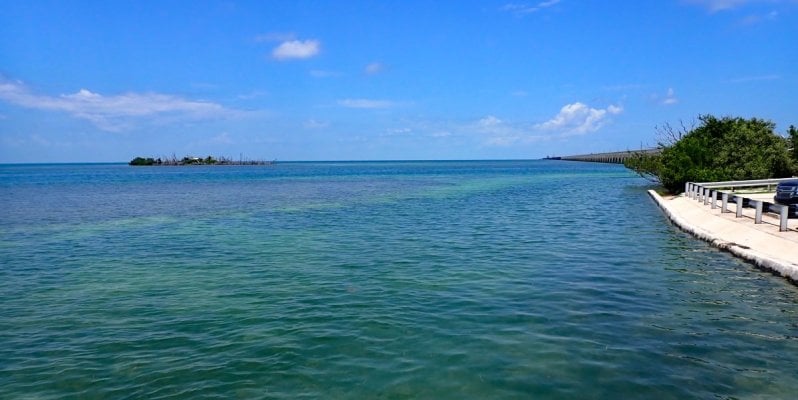
This is Little Money Key as we arrive.
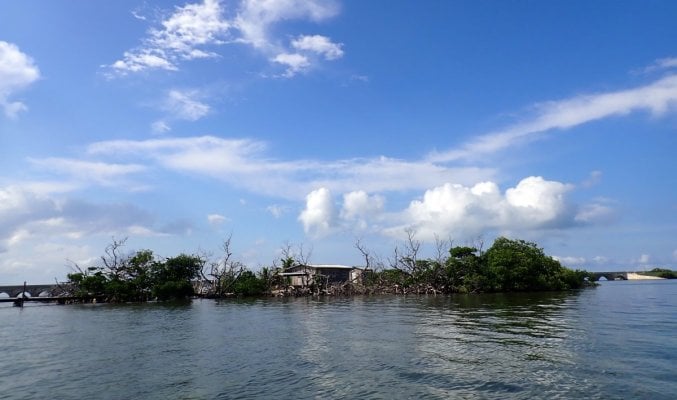
The dock that runs out to the northeast.
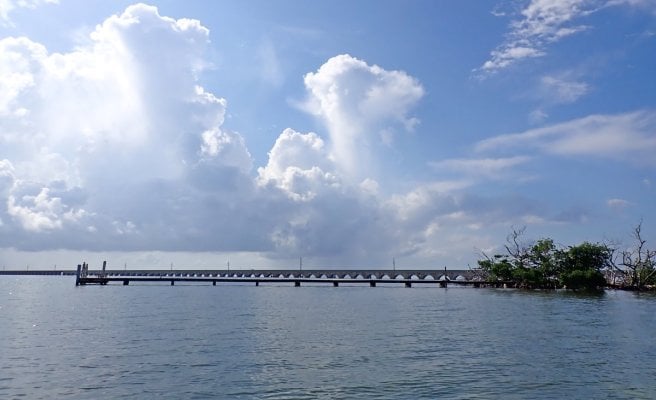
And the view back to the boat ramp at the end of the bridge. You have to love the clear, shallow water where you can see everything on the bottom!
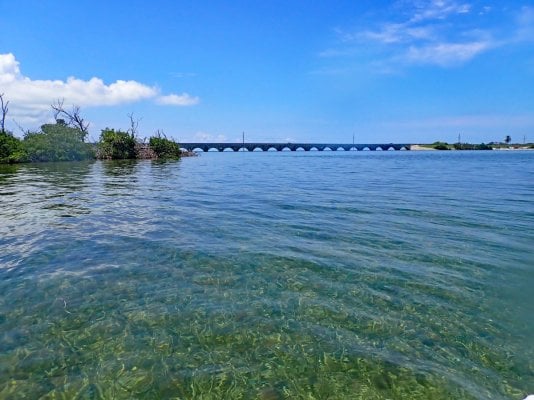
Just as an introduction, Elaine takes a selfie of us.
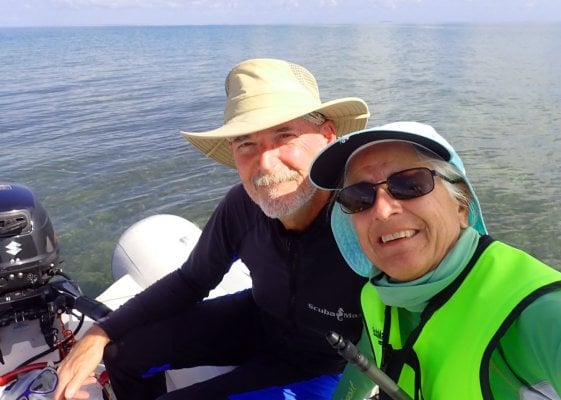
Then we do shots of each other with the first Queen Conch shell we found (more about that below).
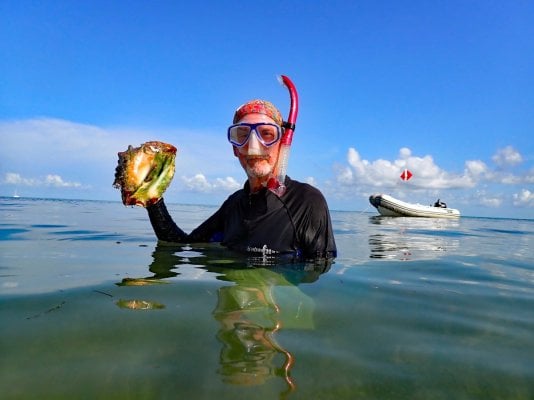
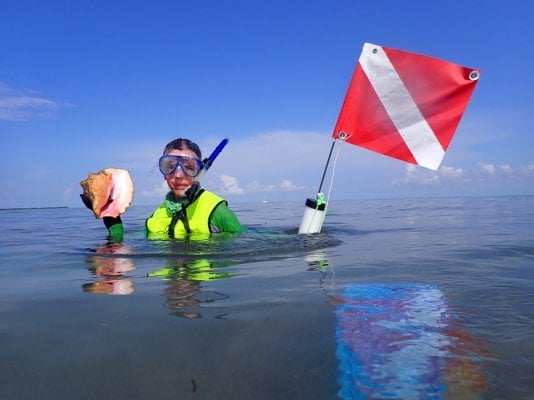
Most all of the conch we found here were very alive and looking healthy. But this shell had been taken over by a few big fire worms (one is hanging out the bottom of the shell) and a small reef octopus (the greenish blob at the top of the opening). We waited and tried to get the octopus to come out for a photo, but it just wasn't interested in cooperating!
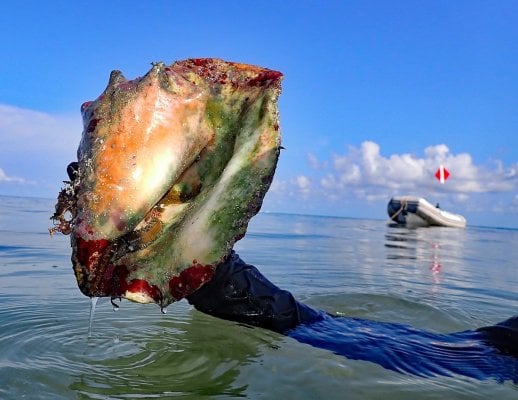
You can see how well conch shells blend into the bottom. Not bad for such a big hard animal.
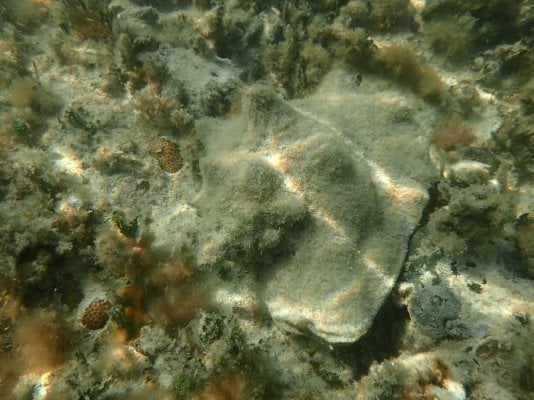
We were keeping an eye on the sky as the rain that was up over Miami was now drifting down toward us. But it did seem to be dissipating over time. We started by swimming in toward shore and over to the dock.
I found this pretty swimmer crab. It was pretty aggressive about defending its territory. That gave Elaine the opportunity to get some good photos. BTW, this guy did NOT get collected by me!
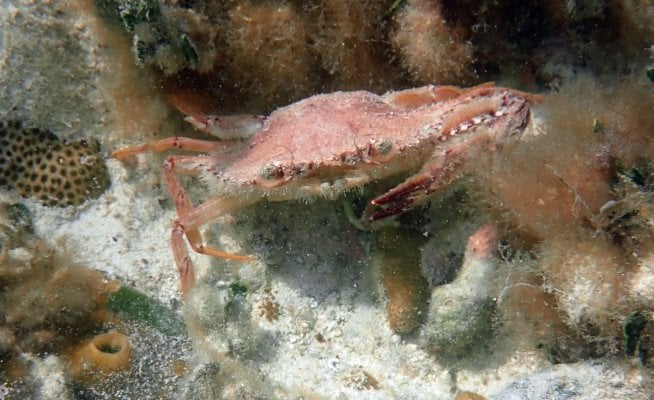
The next find was a little guy that I think is a Decorator crab. You often find them with pieces of sponge on their back. They have small hooks on their carapace that hold the sponge in place.
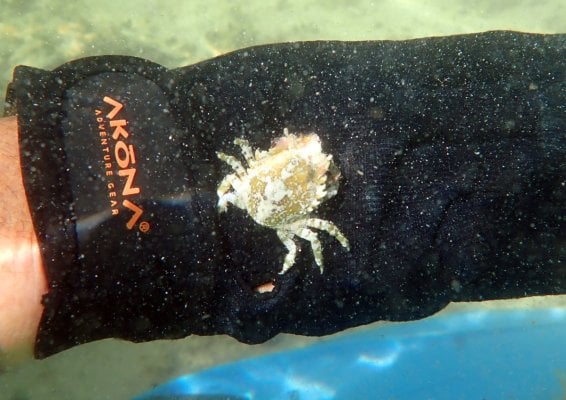
Here is a pretty typical ball sponge. Small ones are the size of a baseball and big ones are bigger than a basketball. They take water in thru small pores all over the surface that looks so 'dusty/sandy' and exhale the now filtered water out the large holes at the top. We sometimes see 'blurry' water streaming out the top as that water has salts remover and doesn't mix with saltwater too quickly, like when you pour fresh water into your aquarium.
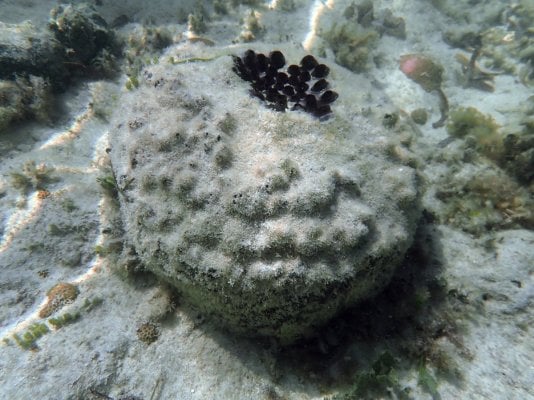
Next up is the very common coral found in the shallows. We call it 'golf ball coral' due to its dimpled surface where the polyps make home. It is a stony coral and therefore illegal to collect. And it does not do well in an aquarium. I don't think it contains any zooxanthellae so there is no photosynthesis. But it does grow almost everywhere in the shallows and encrusts on anything.
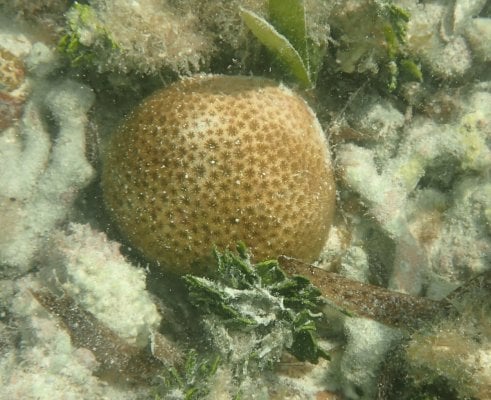
There are several different gorgonians in the area. This is the most common by far. It can survive in an aquarium, however, it does seem to like dirty water rather than pristine water. It also sheds its outer skin every once and a while, probably as a way to rid itself of algae that will grow on it. This can be kind of messy in an aquarium. BTW, gorgonians are NOT protected, so you can collect some. And you don't need to take an entire colony, as you can cut off a chunk and it will heal and do just fine as a new colony.
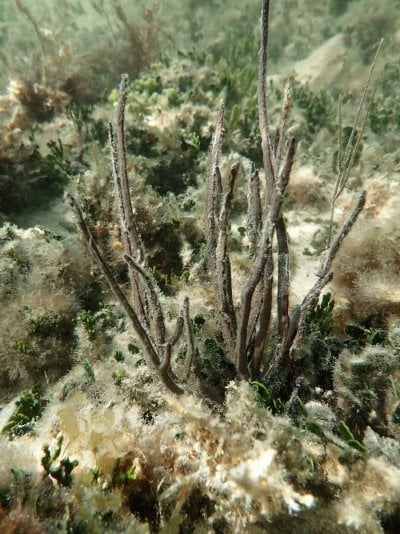
We had been in the water about an hour when the dark clouds and rain were getting close. We were both a bit chilly... OK, Elaine was shivering. So we decided to head back to the boat ramp and maybe even call it a day. I had collected almost everything I wanted yesterday at the Horseshoe, so even I was OK with the idea.
When we got back to the ramp, there was a boat getting ready to pull out that was really taking a long time. So long that we sat through most of the rain and could see blue sky behind the rain cloud. I convinced Elaine to sit and wait to see if the sun coming back out would warm her up. It did and we headed back out to the island (it's barely a 5 minute ride).
We sat in the Zodiac, warmed up with the sun and had our lunch. If you haven't read this before, I'll say it here: snorkeling at Little Money Key, and specifically eating lunch, enjoying being on the water, hearing the little waves slapping up on the boat, being so alone out here, yet the traffic on the Seven Mile Bridge is just 1/4 mile away and can be heard... it's so peaceful and so relaxing. It's one of my favorite spots in the whole world and hardly anybody knows about it or visits there.
The 2nd half of Day 3 later...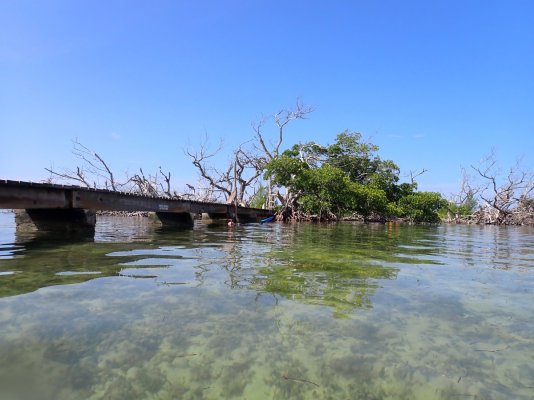
It was raining when we got up. And a check of the weather radar showed a small band of showers moving through and a big batch of showers up near Miami. We waited out the local shower and the headed for the boat ramp at the end of the Seven Mile Bridge.
This is Little Money Key as seen from the water right beside the boat ramp. The Seven Mile Bridge is what goes off to the right. The water here is extremely shallow except for the channel that the tide makes moving in and out between the island we are at here and Little Money Key. At slack tide you could walk 70% of the distance to the island, the other 30% is likely 15 to 30 feet deep and as the tide comes in or goes out, it would be impossible to swim against.

This is Little Money Key as we arrive.

The dock that runs out to the northeast.

And the view back to the boat ramp at the end of the bridge. You have to love the clear, shallow water where you can see everything on the bottom!

Just as an introduction, Elaine takes a selfie of us.

Then we do shots of each other with the first Queen Conch shell we found (more about that below).


Most all of the conch we found here were very alive and looking healthy. But this shell had been taken over by a few big fire worms (one is hanging out the bottom of the shell) and a small reef octopus (the greenish blob at the top of the opening). We waited and tried to get the octopus to come out for a photo, but it just wasn't interested in cooperating!

You can see how well conch shells blend into the bottom. Not bad for such a big hard animal.

We were keeping an eye on the sky as the rain that was up over Miami was now drifting down toward us. But it did seem to be dissipating over time. We started by swimming in toward shore and over to the dock.
I found this pretty swimmer crab. It was pretty aggressive about defending its territory. That gave Elaine the opportunity to get some good photos. BTW, this guy did NOT get collected by me!

The next find was a little guy that I think is a Decorator crab. You often find them with pieces of sponge on their back. They have small hooks on their carapace that hold the sponge in place.

Here is a pretty typical ball sponge. Small ones are the size of a baseball and big ones are bigger than a basketball. They take water in thru small pores all over the surface that looks so 'dusty/sandy' and exhale the now filtered water out the large holes at the top. We sometimes see 'blurry' water streaming out the top as that water has salts remover and doesn't mix with saltwater too quickly, like when you pour fresh water into your aquarium.

Next up is the very common coral found in the shallows. We call it 'golf ball coral' due to its dimpled surface where the polyps make home. It is a stony coral and therefore illegal to collect. And it does not do well in an aquarium. I don't think it contains any zooxanthellae so there is no photosynthesis. But it does grow almost everywhere in the shallows and encrusts on anything.

There are several different gorgonians in the area. This is the most common by far. It can survive in an aquarium, however, it does seem to like dirty water rather than pristine water. It also sheds its outer skin every once and a while, probably as a way to rid itself of algae that will grow on it. This can be kind of messy in an aquarium. BTW, gorgonians are NOT protected, so you can collect some. And you don't need to take an entire colony, as you can cut off a chunk and it will heal and do just fine as a new colony.

We had been in the water about an hour when the dark clouds and rain were getting close. We were both a bit chilly... OK, Elaine was shivering. So we decided to head back to the boat ramp and maybe even call it a day. I had collected almost everything I wanted yesterday at the Horseshoe, so even I was OK with the idea.
When we got back to the ramp, there was a boat getting ready to pull out that was really taking a long time. So long that we sat through most of the rain and could see blue sky behind the rain cloud. I convinced Elaine to sit and wait to see if the sun coming back out would warm her up. It did and we headed back out to the island (it's barely a 5 minute ride).
We sat in the Zodiac, warmed up with the sun and had our lunch. If you haven't read this before, I'll say it here: snorkeling at Little Money Key, and specifically eating lunch, enjoying being on the water, hearing the little waves slapping up on the boat, being so alone out here, yet the traffic on the Seven Mile Bridge is just 1/4 mile away and can be heard... it's so peaceful and so relaxing. It's one of my favorite spots in the whole world and hardly anybody knows about it or visits there.
The 2nd half of Day 3 later...

The stoney coral you posted a pic of looks like a lesser starlet coral (Siderastrea radians), but could possibly be one of a few others. I would need to see it up to close to tell for sure lol. I have 4 colonies of lesser starlets that came on Florida Live Rock from KP. They were just a few polyps on the rocks and are now over 3" in size. As for growing in an aquarium, they require a massive about of par and flow to thrive. Mine are in almost 800 par and get the brunt of a gyre 4k and the returns.This post is going to have a lot of photos. This is the start of Day 3 : Little Money Key
It was raining when we got up. And a check of the weather radar showed a small band of showers moving through and a big batch of showers up near Miami. We waited out the local shower and the headed for the boat ramp at the end of the Seven Mile Bridge.
This is Little Money Key as seen from the water right beside the boat ramp. The Seven Mile Bridge is what goes off to the right. The water here is extremely shallow except for the channel that the tide makes moving in and out between the island we are at here and Little Money Key. At slack tide you could walk 70% of the distance to the island, the other 30% is likely 15 to 30 feet deep and as the tide comes in or goes out, it would be impossible to swim against.

This is Little Money Key as we arrive.

The dock that runs out to the northeast.

And the view back to the boat ramp at the end of the bridge. You have to love the clear, shallow water where you can see everything on the bottom!

Just as an introduction, Elaine takes a selfie of us.

Then we do shots of each other with the first Queen Conch shell we found (more about that below).


Most all of the conch we found here were very alive and looking healthy. But this shell had been taken over by a few big fire worms (one is hanging out the bottom of the shell) and a small reef octopus (the greenish blob at the top of the opening). We waited and tried to get the octopus to come out for a photo, but it just wasn't interested in cooperating!

You can see how well conch shells blend into the bottom. Not bad for such a big hard animal.

We were keeping an eye on the sky as the rain that was up over Miami was now drifting down toward us. But it did seem to be dissipating over time. We started by swimming in toward shore and over to the dock.
I found this pretty swimmer crab. It was pretty aggressive about defending its territory. That gave Elaine the opportunity to get some good photos. BTW, this guy did NOT get collected by me!

The next find was a little guy that I think is a Decorator crab. You often find them with pieces of sponge on their back. They have small hooks on their carapace that hold the sponge in place.

Here is a pretty typical ball sponge. Small ones are the size of a baseball and big ones are bigger than a basketball. They take water in thru small pores all over the surface that looks so 'dusty/sandy' and exhale the now filtered water out the large holes at the top. We sometimes see 'blurry' water streaming out the top as that water has salts remover and doesn't mix with saltwater too quickly, like when you pour fresh water into your aquarium.

Next up is the very common coral found in the shallows. We call it 'golf ball coral' due to its dimpled surface where the polyps make home. It is a stony coral and therefore illegal to collect. And it does not do well in an aquarium. I don't think it contains any zooxanthellae so there is no photosynthesis. But it does grow almost everywhere in the shallows and encrusts on anything.

There are several different gorgonians in the area. This is the most common by far. It can survive in an aquarium, however, it does seem to like dirty water rather than pristine water. It also sheds its outer skin every once and a while, probably as a way to rid itself of algae that will grow on it. This can be kind of messy in an aquarium. BTW, gorgonians are NOT protected, so you can collect some. And you don't need to take an entire colony, as you can cut off a chunk and it will heal and do just fine as a new colony.

We had been in the water about an hour when the dark clouds and rain were getting close. We were both a bit chilly... OK, Elaine was shivering. So we decided to head back to the boat ramp and maybe even call it a day. I had collected almost everything I wanted yesterday at the Horseshoe, so even I was OK with the idea.
When we got back to the ramp, there was a boat getting ready to pull out that was really taking a long time. So long that we sat through most of the rain and could see blue sky behind the rain cloud. I convinced Elaine to sit and wait to see if the sun coming back out would warm her up. It did and we headed back out to the island (it's barely a 5 minute ride).
We sat in the Zodiac, warmed up with the sun and had our lunch. If you haven't read this before, I'll say it here: snorkeling at Little Money Key, and specifically eating lunch, enjoying being on the water, hearing the little waves slapping up on the boat, being so alone out here, yet the traffic on the Seven Mile Bridge is just 1/4 mile away and can be heard... it's so peaceful and so relaxing. It's one of my favorite spots in the whole world and hardly anybody knows about it or visits there.
The 2nd half of Day 3 later...
Steve, it's amazing that you have kept that coral alive, let alone having it grow! Good for you!
I've started moving critters over from the 5g holding tank to the 16g DT. Some of the astrea, nerite and cerith snails, a small sea star, a small yellow cucumber, the big chiton, a small clam and a limpet that both had attached to the chitons rock, 2 small clumps of 2 different algae and an encrusting gorgonian. Over the next week or so I get everbody I want in the new DT moved and then offer up the leftovers to local reefers for free.
I've started moving critters over from the 5g holding tank to the 16g DT. Some of the astrea, nerite and cerith snails, a small sea star, a small yellow cucumber, the big chiton, a small clam and a limpet that both had attached to the chitons rock, 2 small clumps of 2 different algae and an encrusting gorgonian. Over the next week or so I get everbody I want in the new DT moved and then offer up the leftovers to local reefers for free.
That sounds like an awesome plan.Steve, it's amazing that you have kept that coral alive, let alone having it grow! Good for you!
I've started moving critters over from the 5g holding tank to the 16g DT. Some of the astrea, nerite and cerith snails, a small sea star, a small yellow cucumber, the big chiton, a small clam and a limpet that both had attached to the chitons rock, 2 small clumps of 2 different algae and an encrusting gorgonian. Over the next week or so I get everbody I want in the new DT moved and then offer up the leftovers to local reefers for free.
I will be heading to FL the first of July and plan to snorkel/dive off the coast of Stuart and do some snorkeling inshore in the lagoon. Last trip down, where I was able to do that, I found tons of gorgs and numerous coral colonies (startlet corals, some fire coral and a few others) in the Indian River Lagoon. Need to be sure load up the Go-Pro this time, so I can take pics. Just snorkeling bathtub beach reef and the wrecks around the coast is enough enjoyment for me. Especially bathtub, as it is an awesome spot.
Will also hit the Fort Pierce jetty to collect some more zoas at low tide. The colonies have been exploding the last few years and it is cool to see them out of the water at low tide.
Here is a pic of one of the lesser starlets that managed to live and grow. Also some pics of other things collected or seen.
Lesser starlet with polyps out and a merten that decided to post up next to it. Didnt harm the coral at all. Hard to not a have get near something when you have 60+ different nems in a 7' tank lol.
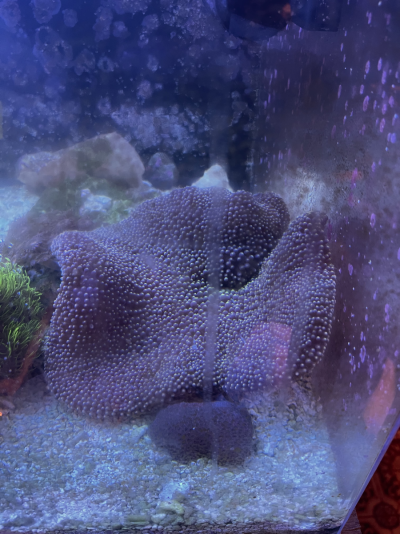
My upside down jellies
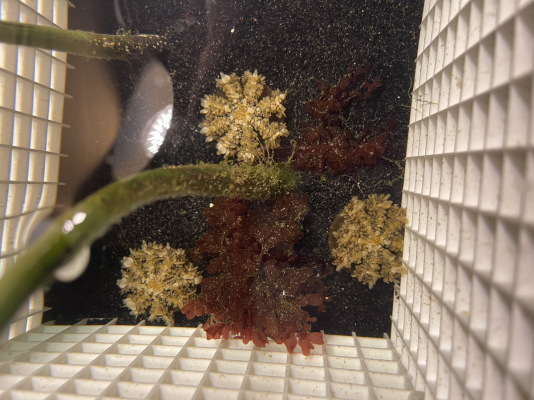
Some of the NPS nems.
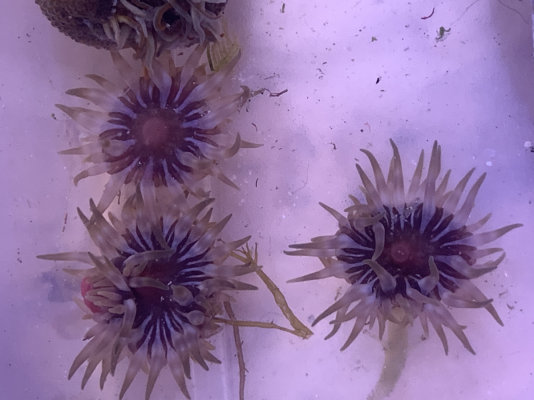
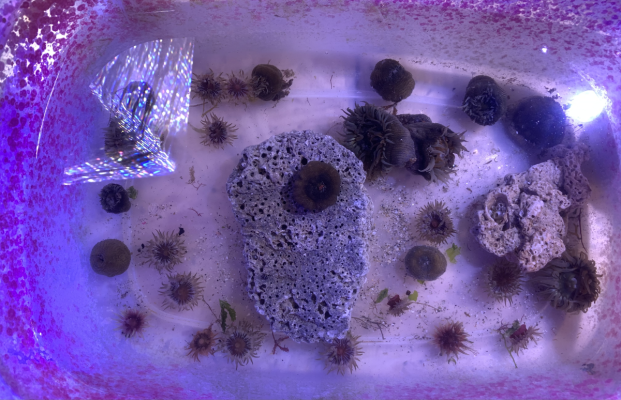
SPL Zoa rules, just to show thart there is no need for me to collect as much as I am allowed to lol.

Zoas at Ft. Pierce Jetty
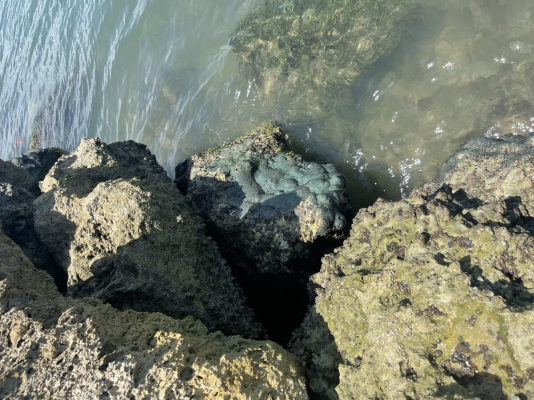
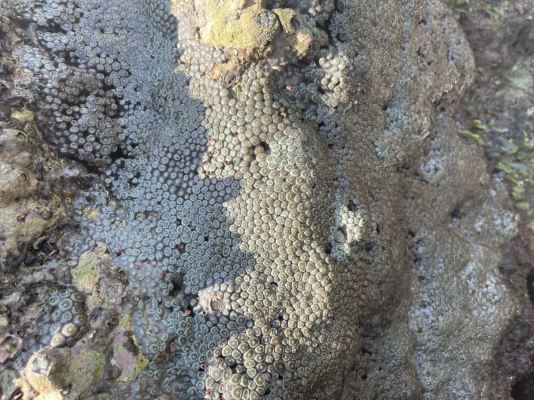
Zoas from Jetty under a Kessil a360 that I carry with me to keep things in light at my house in FL.(They sit on back porch in a cooler with filtrations and this light lol) Light was at 60% color and 25% intensity.
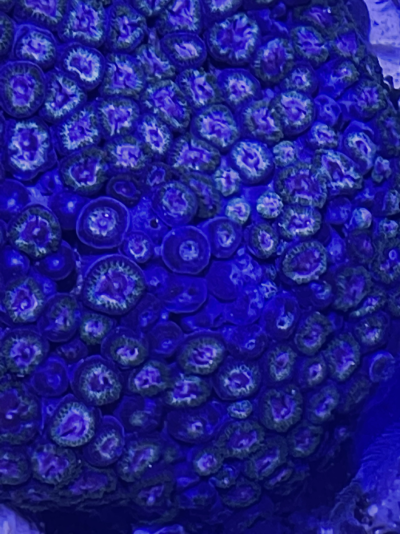
Day 3, part 2:
After lunch we got back in the water. It was almost clear blue sky and very little wind. Here we are just after lunch. Elaine didn't like that I have the dive flag pole sticking up out of her head!
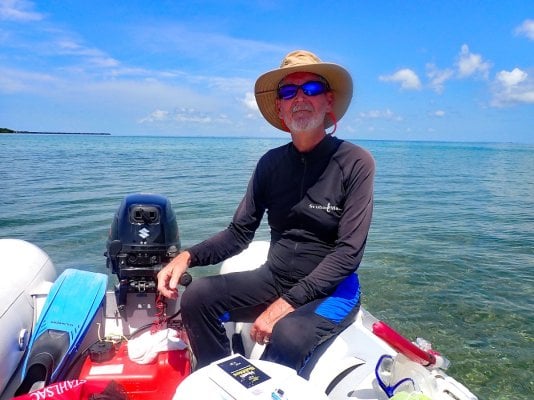
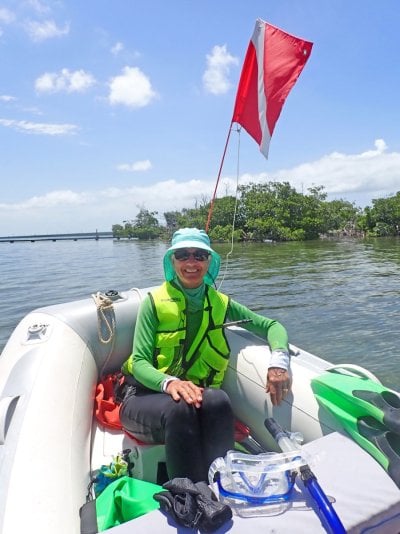
The water had become quite flat, which makes for great snorkeling!
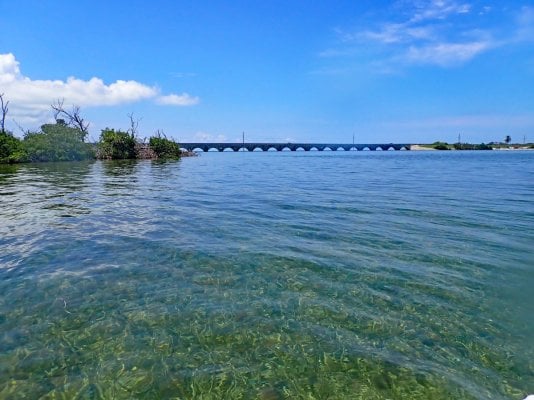
Early on, in the grassy area we found some emerald crabs.
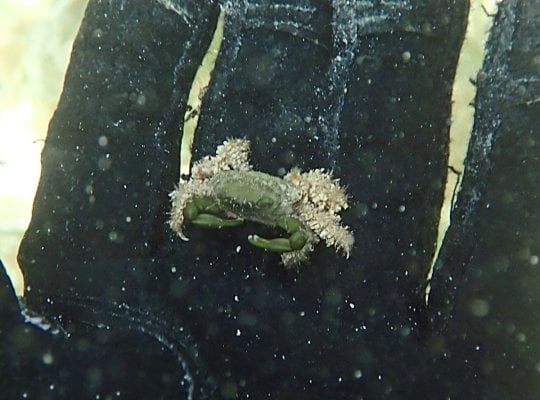
Elaine took this photo. You can see just how much life there is on just one rock. I didn't collect these curly-cue anemones, but I did get one later.
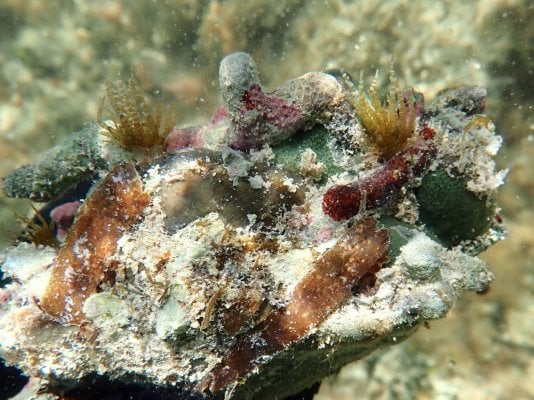
We got over by the dock and worked our way out toward the end.
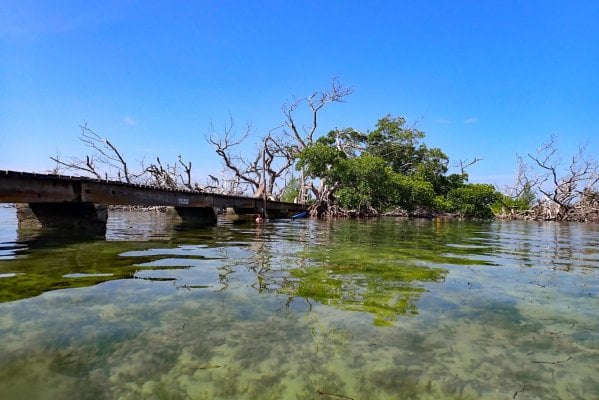
It's more sandy here and there are more rocks. At one point I had 3 rocks in a row with big brown sea stars under each one! Elaine was taking a fish photo, but I think you get the idea of what the area looks like behind the fish.
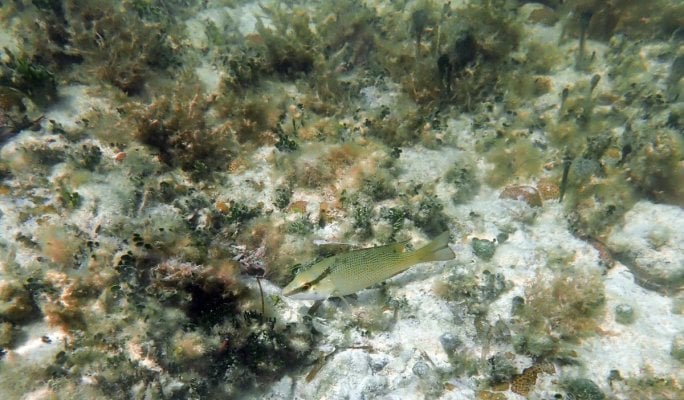
The smaller fish love to school in the shadow of the dock. They are here every time we swim nearby. I'm always amazed at how many there are. This was like a 20 foot long wall of little fish!
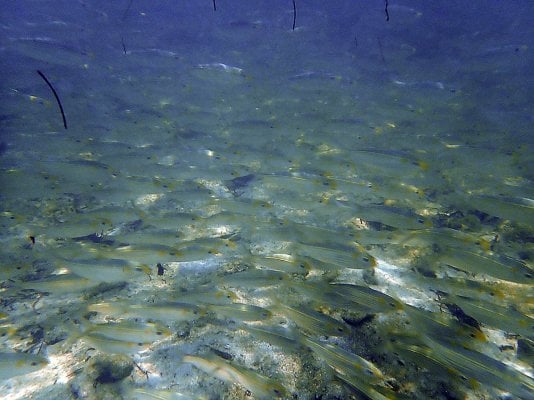
As we headed back toward the Zodiac, we were in deeper water (like 3 to 4 feet deep). We saw some interesting sponges.

A Hawk Wing conch, which we only find very rarely.
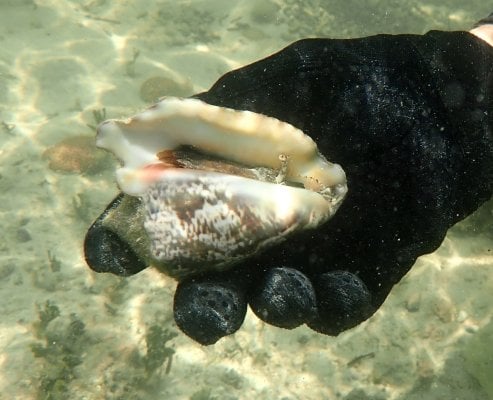
Some rock boring urchins. These are super pretty in the bright sunlight, but are difficult to keep in a reef tank.
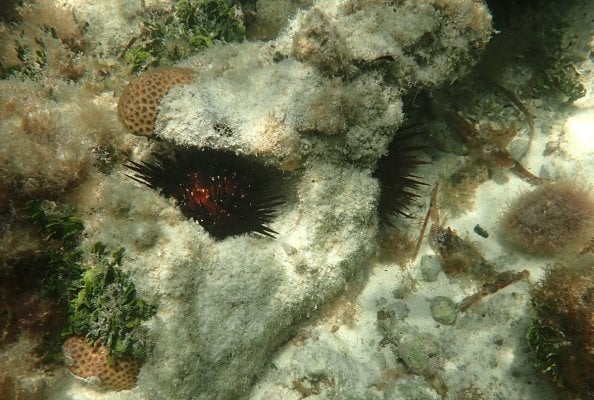
We came up for air and not far from us there was a gathering of Cormorants. We see them in small numbers frequently. And some days the dock has dozens of them drying out after swimming. But neither of us has seen a group like this in the water. There may have been a school of tiny fish there.
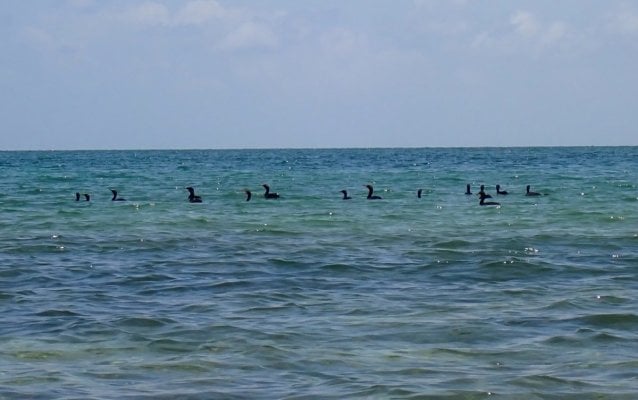
Elaine also got this shot of our Zodiac that I like. It looks so isolated and alone.
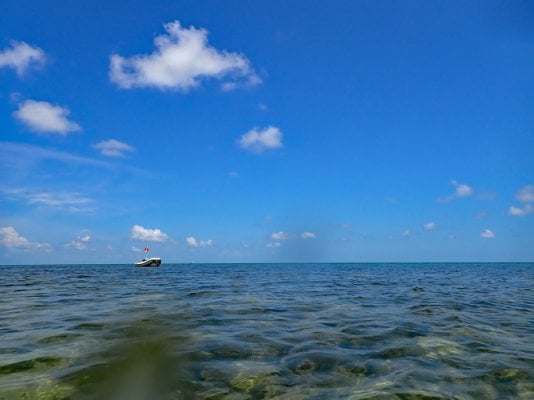
She also took a shot of the house on the island. I doubt that it has been used since Hurricane Irma, 5 years ago. It's in pretty rough shape. But there were a couple of wheelbarrows up there which tells me somebody is doing something. They would surely have been washed away by the hurricane.
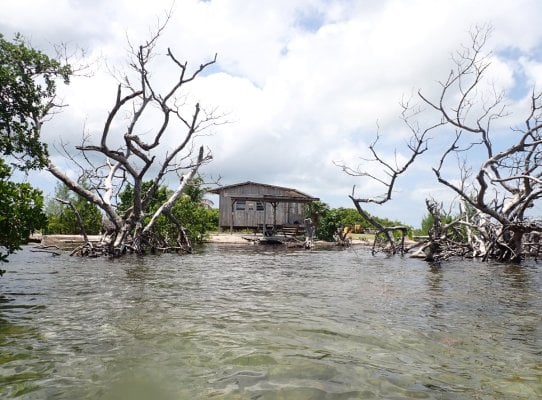
One of the slightly less common, and I think prettier gorgonians.
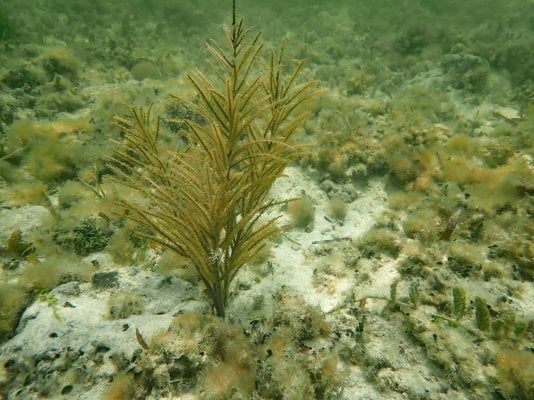
We saw as many or more fire worms than we ever have.
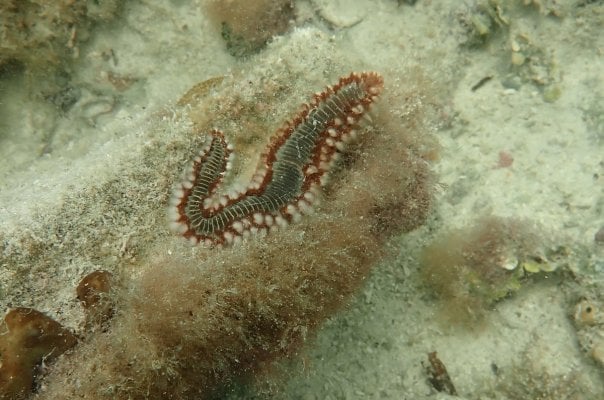
Elaine loves feather dusters like this. But they are difficult to collect because they attach to the rocks so well that the odds are quite high that you will kill the worm trying to remove it. I got lucky this time and found one attached to a small piece of dead coral. I'm being very careful with it and keeping it in its own bowl for now.
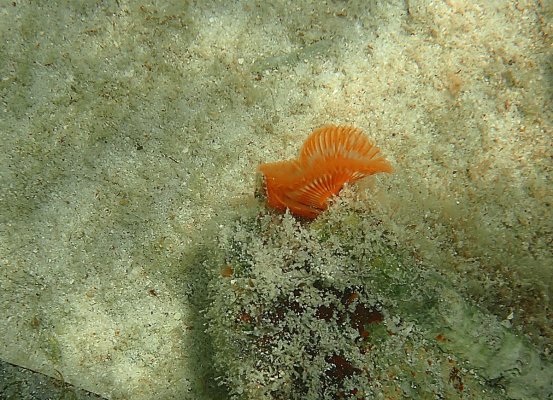
I did collect a couple of these chitons which tend to live under loose rocks.
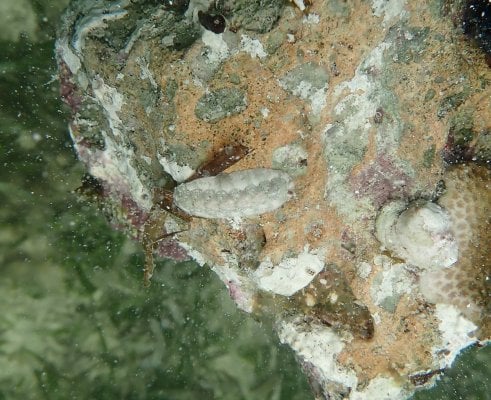
And I took 2 encrusting gorgonians. One had covered a 5" tall branching gorgonian and the other was just a ball like this one.
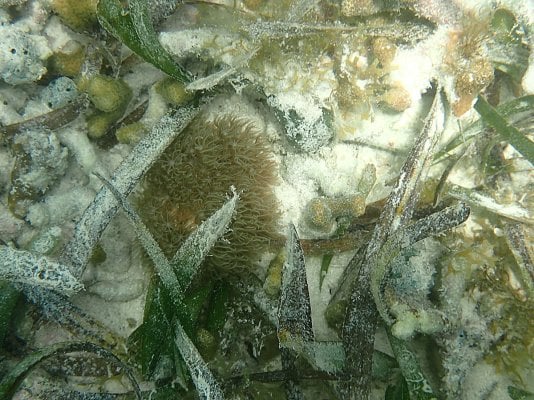
At one point we were up very, very close to the mangroves along the shoreline. I swa what I at first thought was a pile of dead cerith snails. And I wondered why they were all together. There must have been a couple hundred. I called Elaine over to get a photo. When I pointed at the group I wanted photographed, I touched the shells and they started to move! It was a convention (or maybe an orgy) of tiny hermit crabs! This was one of 3 groups like this , all within 2 feet of each other.
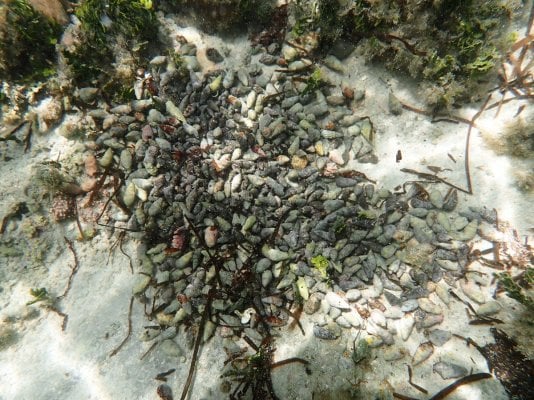
Elaine found these 2 sea stars together. The one on top doesn't look like much in this photo, but I had one in the livestock I sold. Under good light and from directly above, the blue central disk get a translucent sapphire blue look. It's very cool. If Elaine had shown me this star, I would have collected it and let the 2 I had go.
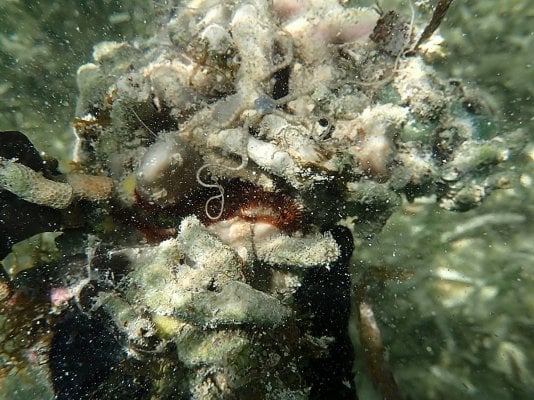
This is very typical of the 'finger' coral that is all over the shallows around the Keys. It grows, it gets tumbled in the storms and broken. Parts get buried in the sand and die. It's everywhere, but it is a stony coral and therefore illegal!
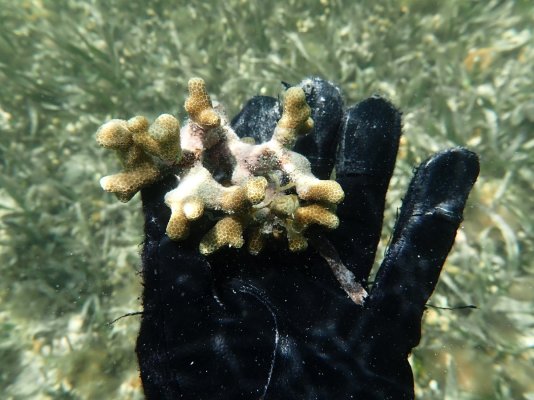
On the other hand, every once and a while we find a nice head of a different stony coral. In the bright sun it's a glorious striking yellow. And this on was nat attached to anything, so I picked it up to show you how big it is.
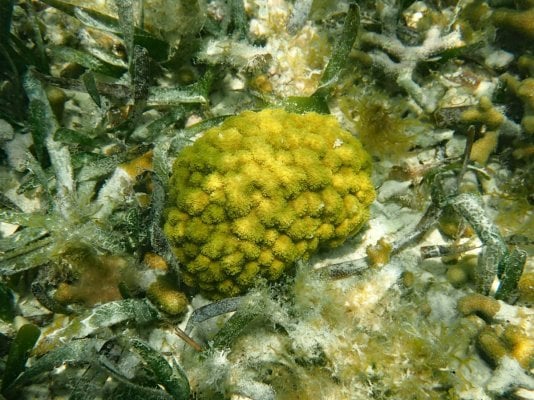
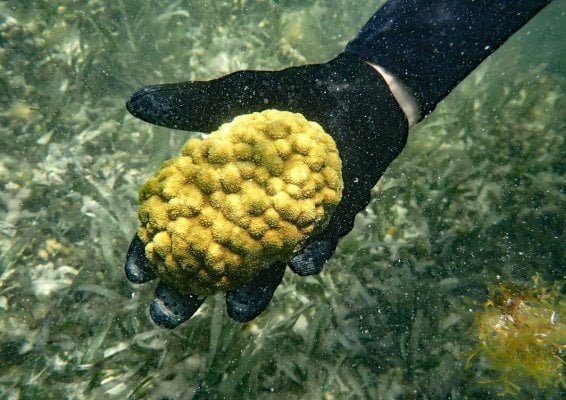
More coral growing inside an old cinder block. And again, a good chance I could have netted a fish or two! LOL!
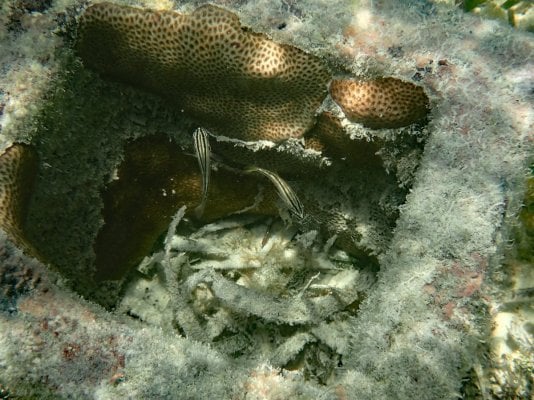
Just in case you ever get the feeling that you are being watched while you are out snorkeling, here is one of the watchers with crazy eyes!
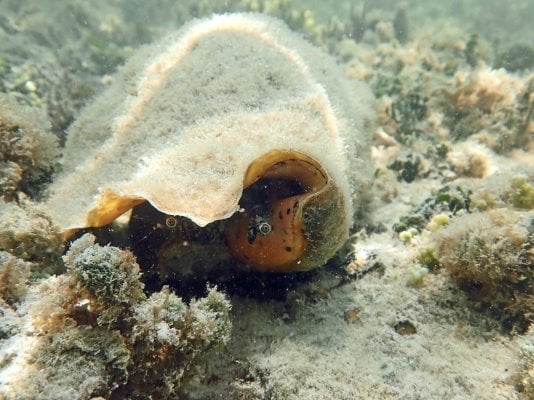
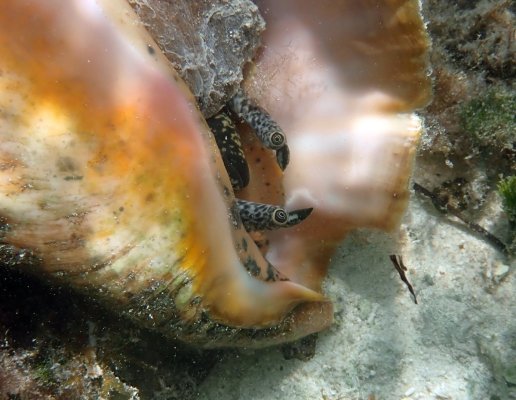
And as we were about to end our snorkel we came across a nice big queen conch shell with no mollusk inside. Instead, it had a huge hermit crab. Turning the shell over made it dart back inside. So, we hung around for about 5 minutes waiting for a better look and a better photo opportunity!
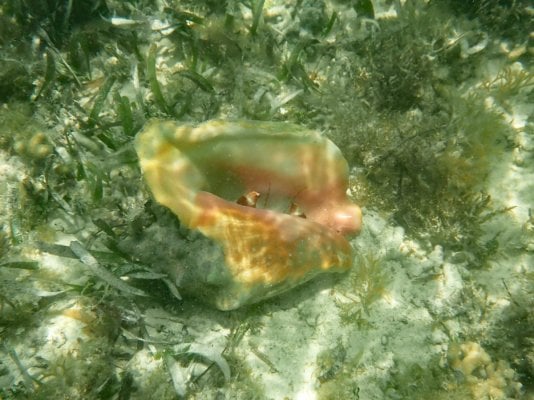
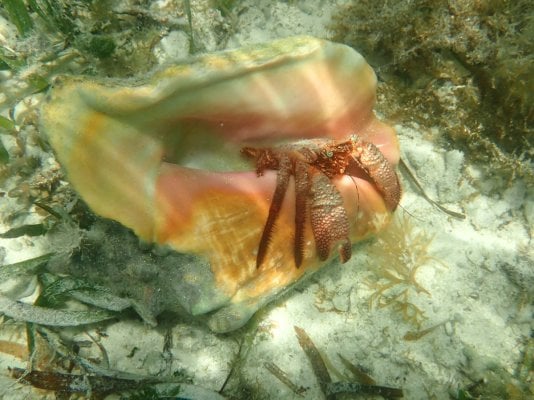
That wraps up 3 days of snorkeling and I hope you found this interesting and/or informative. If anybody has any comments or questions, I'm happy to hear them.
I do have one more post to make. That will be the sorting, counting and photographing the collection as I'm putting them into a holding tank. And by the time I get that done, I may have a photo or two of some of the collection in the DT.
Stay tuned.
After lunch we got back in the water. It was almost clear blue sky and very little wind. Here we are just after lunch. Elaine didn't like that I have the dive flag pole sticking up out of her head!


The water had become quite flat, which makes for great snorkeling!

Early on, in the grassy area we found some emerald crabs.

Elaine took this photo. You can see just how much life there is on just one rock. I didn't collect these curly-cue anemones, but I did get one later.

We got over by the dock and worked our way out toward the end.

It's more sandy here and there are more rocks. At one point I had 3 rocks in a row with big brown sea stars under each one! Elaine was taking a fish photo, but I think you get the idea of what the area looks like behind the fish.

The smaller fish love to school in the shadow of the dock. They are here every time we swim nearby. I'm always amazed at how many there are. This was like a 20 foot long wall of little fish!

As we headed back toward the Zodiac, we were in deeper water (like 3 to 4 feet deep). We saw some interesting sponges.

A Hawk Wing conch, which we only find very rarely.

Some rock boring urchins. These are super pretty in the bright sunlight, but are difficult to keep in a reef tank.

We came up for air and not far from us there was a gathering of Cormorants. We see them in small numbers frequently. And some days the dock has dozens of them drying out after swimming. But neither of us has seen a group like this in the water. There may have been a school of tiny fish there.

Elaine also got this shot of our Zodiac that I like. It looks so isolated and alone.

She also took a shot of the house on the island. I doubt that it has been used since Hurricane Irma, 5 years ago. It's in pretty rough shape. But there were a couple of wheelbarrows up there which tells me somebody is doing something. They would surely have been washed away by the hurricane.

One of the slightly less common, and I think prettier gorgonians.

We saw as many or more fire worms than we ever have.

Elaine loves feather dusters like this. But they are difficult to collect because they attach to the rocks so well that the odds are quite high that you will kill the worm trying to remove it. I got lucky this time and found one attached to a small piece of dead coral. I'm being very careful with it and keeping it in its own bowl for now.

I did collect a couple of these chitons which tend to live under loose rocks.

And I took 2 encrusting gorgonians. One had covered a 5" tall branching gorgonian and the other was just a ball like this one.

At one point we were up very, very close to the mangroves along the shoreline. I swa what I at first thought was a pile of dead cerith snails. And I wondered why they were all together. There must have been a couple hundred. I called Elaine over to get a photo. When I pointed at the group I wanted photographed, I touched the shells and they started to move! It was a convention (or maybe an orgy) of tiny hermit crabs! This was one of 3 groups like this , all within 2 feet of each other.

Elaine found these 2 sea stars together. The one on top doesn't look like much in this photo, but I had one in the livestock I sold. Under good light and from directly above, the blue central disk get a translucent sapphire blue look. It's very cool. If Elaine had shown me this star, I would have collected it and let the 2 I had go.

This is very typical of the 'finger' coral that is all over the shallows around the Keys. It grows, it gets tumbled in the storms and broken. Parts get buried in the sand and die. It's everywhere, but it is a stony coral and therefore illegal!

On the other hand, every once and a while we find a nice head of a different stony coral. In the bright sun it's a glorious striking yellow. And this on was nat attached to anything, so I picked it up to show you how big it is.


More coral growing inside an old cinder block. And again, a good chance I could have netted a fish or two! LOL!

Just in case you ever get the feeling that you are being watched while you are out snorkeling, here is one of the watchers with crazy eyes!


And as we were about to end our snorkel we came across a nice big queen conch shell with no mollusk inside. Instead, it had a huge hermit crab. Turning the shell over made it dart back inside. So, we hung around for about 5 minutes waiting for a better look and a better photo opportunity!


That wraps up 3 days of snorkeling and I hope you found this interesting and/or informative. If anybody has any comments or questions, I'm happy to hear them.
I do have one more post to make. That will be the sorting, counting and photographing the collection as I'm putting them into a holding tank. And by the time I get that done, I may have a photo or two of some of the collection in the DT.
Stay tuned.
Attachments
Steve, where did this come from? And what is SPL?
This is the regulation I work from: Corallimorphs and Zoanthids: No more than 5 single polyps of each may be landed per person per day within 20-organism aggregate, must be harvested with a flexible blade no wider than 2" such as a putty knife, razor blade, or paint scraper.
It is from the below. SPL is "Saltwater Products License". To collect marine life, you must have Marine Life endorsement. Lots of things to fill out, things to report for income based on collection of marine life using an SPL, etc. I do also own a private business in FL that is a registered wholesaler with the proper authorities. I collect and sell to myself, all legal and done correctly. Took about 2 years to work it all out and do things by the books. This is even with my brother working for FWC and having access to endless amounts of info from people he knows. Especially as I am based out of TN, but have a residence in FL. The way the laws are written, amendments and such, it is very hard to interpret if not a resident ( I would need to live there 6 months and 1 day a year to be classified as a resident for this purpose, yet have cars registered down there and a physical address) and not collecting for the aquarium trade. Long story short, macro is my main collection item. There is a massive demand for it and not for what you think. The SPL was mainly for it and I added the MLD to it for collection of allowable corals/fish. But back to the macro, 90% of the macro I collect goes to human consumption. 10% goes elsewhere. Like macro for tanks and fertilizer. The fertilizer part is only the parts that do not make it. When collecting the amount of macro I do, there is loss. Not much, but it doesnt always do well in tubs on the boat.Steve, where did this come from? And what is SPL?
This is the regulation I work from: Corallimorphs and Zoanthids: No more than 5 single polyps of each may be landed per person per day within 20-organism aggregate, must be harvested with a flexible blade no wider than 2" such as a putty knife, razor blade, or paint scraper.
Amazing! I live in Homestead, FL about 45 minutes from the keys and in mid / end of march went to Bahia Honda for the first time. I very much enjoyed it. I didnt go with intentions of snorkeling, and tbh I had never snorkeled before.  I just so happened to have my brothers facemask and I was in the water for a bit looking at all the wildlife.
I just so happened to have my brothers facemask and I was in the water for a bit looking at all the wildlife.
Thank you for sharing your experience, looking forward to the next post with the goods!
Thank you for sharing your experience, looking forward to the next post with the goods!
Similar threads
- Replies
- 2
- Views
- 89
- Replies
- 17
- Views
- 597






